Paul van Yperen's Blog, page 279
March 4, 2018
Who is Souricette?
Recently, I bought this little cigarette card (4 by 6 cm; 1.7 by 2.7 inch) and wondered if the Souricette on the picture could be French actress Musidora (1889-1957). With her heavily kohled dark eyes, somewhat sinister make-up, pale skin and exotic wardrobes, she created an unforgettable vamp persona in the Louis Feuillade serial Les Vampires (1915-1916). Her Irma Vep is a voluptuous, amoral villainess, who wears the same black leotard, hood and tights as Souricette on my cigarette card. I googled Musidora and found images of her in the same style and costume, but not this particular picture. Nor did I find an indication that her picture was used by Cigarettes Le Nil. So I asked two ladies for help.
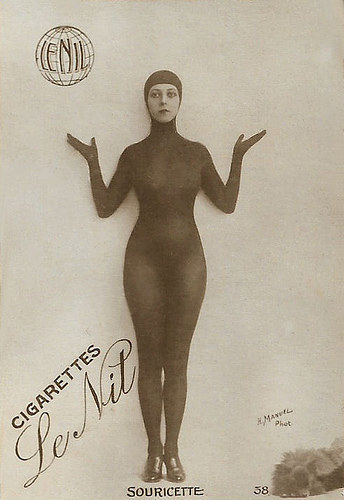
French cigarette card by Cigarettes Le Nil, no. 38. Photo: H. Manuel.
Thieves operating in hotels
First I mailed with Marlene Pilaete of La Collectionneuse and asked her if this could be Musidora or an imitator. Marlene is a real Mrs. Sherlock who often helps me with little postcard mysteries and corrects my errors at European Film Star Postcards.
Marlene replied me: "This cigarette card is a good find. Of course, I cannot be sure at 100% but I really think she’s Musidora . Her distinctive face is recognizable. I have among my vintage Musidora cards one on which she is exactly dressed the same way (but the pose is different). I even recognize her shoes.
Musidora has been photographed several times by the Manuel studios, so this is a further clue.
I don’t know why she is called 'Souricette' on this cigarette card. She is dressed here in her famous costume from Les vampires. It’s a typical outfit worn by the thieves operating in hotels.
You certainly remember that in Alfred Hitchcock’s To Catch a Thief, Cary Grant and Brigitte Auber also wear this kind of leotard. In French, those thieves are called 'souris d’hôtel'. 'Souricette' being a kind of diminutive form of 'souris', maybe that’s where the publishers got their idea."
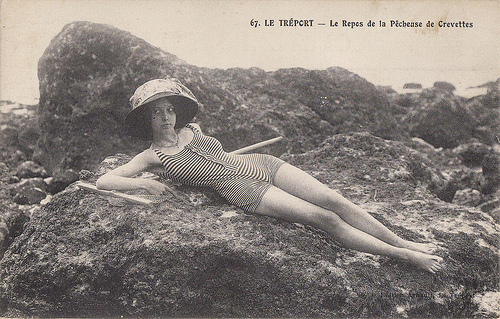
French postcard, no. 67. Caption: Le Tréport - Le Repos de la Pêcheuse de Crevettes. (Le Tréport - The Rest of the Shrimp Fisherwoman). Musidora working as a bathing beauty for picture postcards. Collection: Marlène Pilaete.
A Dog called Lacsalé
I also contacted Dutch film historian Annette Förster, author of Women in Silent Cinema. Histories of Fame and Fate , which has been selected for the prestigious Choice Outstanding Academic Titles list 2017.
Her book is a study on the comprehensive accounts of the professional itineraries of three women in the international silent cinema: Dutch stage and film actress Adriënne Solser, Canadian-born actress and filmmaker Nell Shipman, and Musidora .
Annette writes me: "I'm pretty sure that this is Musidora , not so much because of all the similarities, but mainly because of the dog in the lower right corner: that is her own dog Lacsalé!
He is also on other publicity photos of Musidora , such as those by Photogenie that she had sent to Cinéa (see my book on page 243).
What a great find!"
Thank you, Marlène and Annette, and Lacsalé too!
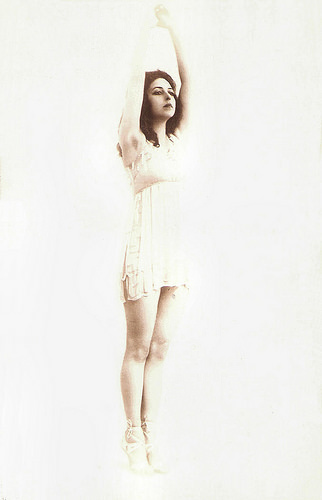
French postcard by Editions Gordon & Cie., Vincennes (Seine).

French cigarette card by Cigarettes Le Nil, no. 38. Photo: H. Manuel.
Thieves operating in hotels
First I mailed with Marlene Pilaete of La Collectionneuse and asked her if this could be Musidora or an imitator. Marlene is a real Mrs. Sherlock who often helps me with little postcard mysteries and corrects my errors at European Film Star Postcards.
Marlene replied me: "This cigarette card is a good find. Of course, I cannot be sure at 100% but I really think she’s Musidora . Her distinctive face is recognizable. I have among my vintage Musidora cards one on which she is exactly dressed the same way (but the pose is different). I even recognize her shoes.
Musidora has been photographed several times by the Manuel studios, so this is a further clue.
I don’t know why she is called 'Souricette' on this cigarette card. She is dressed here in her famous costume from Les vampires. It’s a typical outfit worn by the thieves operating in hotels.
You certainly remember that in Alfred Hitchcock’s To Catch a Thief, Cary Grant and Brigitte Auber also wear this kind of leotard. In French, those thieves are called 'souris d’hôtel'. 'Souricette' being a kind of diminutive form of 'souris', maybe that’s where the publishers got their idea."

French postcard, no. 67. Caption: Le Tréport - Le Repos de la Pêcheuse de Crevettes. (Le Tréport - The Rest of the Shrimp Fisherwoman). Musidora working as a bathing beauty for picture postcards. Collection: Marlène Pilaete.
A Dog called Lacsalé
I also contacted Dutch film historian Annette Förster, author of Women in Silent Cinema. Histories of Fame and Fate , which has been selected for the prestigious Choice Outstanding Academic Titles list 2017.
Her book is a study on the comprehensive accounts of the professional itineraries of three women in the international silent cinema: Dutch stage and film actress Adriënne Solser, Canadian-born actress and filmmaker Nell Shipman, and Musidora .
Annette writes me: "I'm pretty sure that this is Musidora , not so much because of all the similarities, but mainly because of the dog in the lower right corner: that is her own dog Lacsalé!
He is also on other publicity photos of Musidora , such as those by Photogenie that she had sent to Cinéa (see my book on page 243).
What a great find!"
Thank you, Marlène and Annette, and Lacsalé too!

French postcard by Editions Gordon & Cie., Vincennes (Seine).
Published on March 04, 2018 22:00
March 3, 2018
Jacqueline Francell
During the 1930s and 1940s, Jacqueline Francell (1908-1962) was a popular star of the French operetta. She also appeared in operas at the Théâtre des Champs-Élysées, and in 1930, she created the role of Princess Blanche-Aline in Les Aventures du roi Pausole by Arthur Honegger. She also starred in a dozen films between 1931 and 1944.
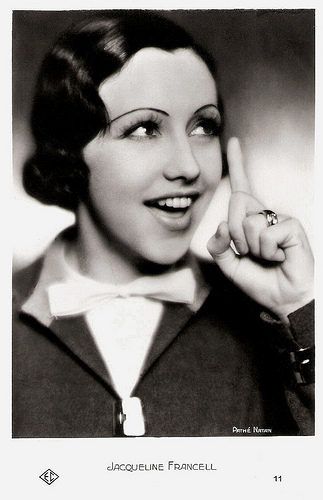
French postcard by EC (Editions Chantal), Paris, no. 11. Photo: Pathé Natan.
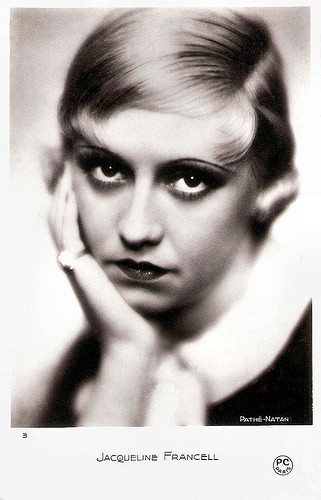
French postcard by PC, Paris, no. 11. Photo: Pathé Natan.
The Chocolate Girl
Jacqueline Francell was born Jacqueline Anne Marie Etiennette François in Paris in 1908. Her father was the tenor and later vocal teacher Fernand Francell.
She started her operetta career in 1928 in Déshabillez-vous! (1928), at the Théâtre des Bouffes Parisiens. Her second part, the title role in Flossie (1929) by Joseph Szulc, made her a star and critics compared her to Lilian Harvey and Meg Lemonnier .
From then on she created roles in operettas and musicals like Un soir de réveillon (New Year’s Eve) with Henri Garat , Arsène Lupin, banquier (1930), alongside Jean Gabin , La Pouponnière (1932), Oh ! Papa !... (1933) at the Théâtre des Nouveautés, and Florestan 1er, prince de Monaco (1933) by Sacha Guitry at the Théâtre des Variétés. Her affair with Jean Gabin in 1930-1931 caused the end of his marriage with Gaby Basset.
Francell also appeared in operas at the Théâtre des Champs-Élysées, and created the role of Princess Blanche-Aline opposite Dorville in the title role in the opera Les Aventures du roi Pausole (The Adventures of King Pausole, 1930) by Arthur Honegger.
She later performed in Le guéridon Empire (1936), a revue by Rip at La Comédie des Champs-Élysées, and La Margoton du bataillon (1937) with Suzy Delair . She also recorded songs from most of these musicals. She presented her tour de chant at the Théâtre de l’Empire and played in the operetta La jeune fille dans le soleil (The young girl in the sun, 1937) by Claude Pigault, the pianist who accompanied her at l’Empire.
The following years, she starred in Mon cœur hésite (1938) at the Théâtre Antoine and Balalaïka (1938) at the Théâtre Mogador with Réda Caire .
Jacqueline Francell also starred in a dozen films. She co-starred with Raimu in her debut, the comedy La petite chocolatière/The Chocolate Girl (Marc Allégret, 1932), an adaptation of Paul Gavault's play The Chocolate Girl. It made her a star of the French cinema. In another comedy, Enlevez-moi/Abduct Me (Léonce Perret, 1932), she co-starred with Roger Tréville and Arletty .
For Paramount, she made L'amour guide (Jean Boyer, Gilbert Pratt, 1933) with Maurice Chevalier . It was alternate-language version of The Way to Love (Norman Taurog, 1933) in which Ann Dvorak played Chevalier’s love interest. It was the time of the alternate language films. She also appeared in an alternate-language version of the German film Großstadtnacht (Fyodor Otsep, 1932), Mirages de Paris/Mirages of Paris (Fyodor Otsep, 1933) in which she replaced Dolly Haas .
She was the co-star of Adolph Wohlbruck in the French-German operetta Der Zigeunerbaron/Le baron tzigane/The Gypsy Baron (Pierre Chomette, 1935). The drama L'Appel du Silence/The Call of Silence (Léon Poirier, 1936), also starring Jean Yonnel and Pierre de Guingand , is a biography based on the life of the Catholic missionary Charles de Foucauld who worked in the Sahara. Two years later, she made her final feature film Coeur de gosse/Kid's heart (George Pallu, 1938) featuring Gabriel Farguette.
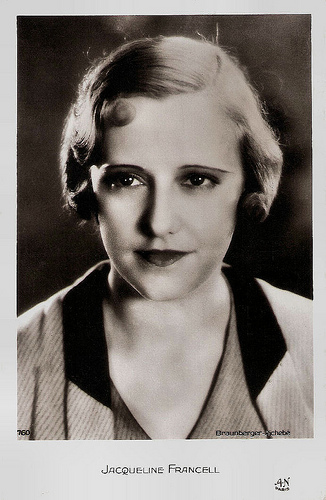
French postcard by A.N., Paris, no. 760. Photo: Braunberger-Richebé.
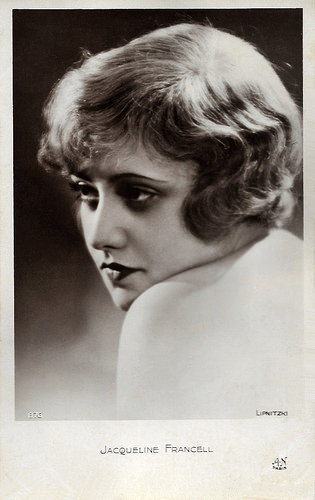
French postcard by A.N., Paris, no. 876. Photo: Lipnitzki.
Jeanne d'Arc
The war and the occupation did not stop Jacqueline Francell’s career. In 1941, she took over the lead of the stage operetta Passionnément (Passionately) at the Théâtre Marigny. In 1944, she was one of the narrators of the documentary De Jeanne d'Arc à Philippe Pétain/1429-1942 (Sacha Guitry, 1944).
DB DuMonteil at IMDb : “This film was shown in the movie theaters two months before the landing and afterward completely disappeared only to reappear in 1993. This is of course a propaganda movie. But not more than Stelli's Le Voile Bleu. Beginning his movie with an evocation of Joan of Arc was not completely incongruous; Guitry probably thought it was a sign from God; 1429: Joan's odyssey begins; birth of the Homeland, 1942: under the yoke of the Nazis, but still proud of its past, the country remembers. 1429-1942 sinister anagram. Joan found since taken over by the far right wing.”
After the war, Jacqueline Francell played with Jimmy Gaillard in Plume au vent (1948) by Jean Nohain and Claude Pingault at the Comédie des Champs-Élysées.
She married Gabriel Bouillon, brother of the conductor Jo Bouillon and returned to the Marigny Theatre for Chives. She then performed at the Monte-Carlo Opera and became a star of the National Radio. At the Théâtre de la Potinière, she played La Bride sur le cou (1947) by Philippe Parès with Yves Furet, with whom she also co-starred at the Casino de Cannes in Mozart (1948) by Sacha Guitry . Marcel Achard asked her to take over the role of Jandeline in Patate at the Théâtre Saint-Georges.
In 1962, after fainting, she was transported to the emergency room at the Ambroise-Paré clinic in Neuilly and died there after an operation. Jacqueline Francell was 54.
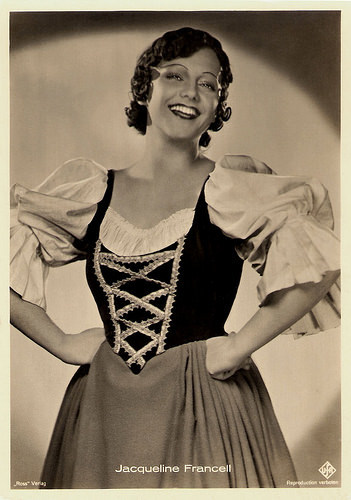
German postcard by Ross Verlag. Photo: Ufa. Publicity still for Le baron tzigane/The Gypsy Baron (Pierre Chomette, 1935).
Sources: Marlène Pilaete (La Collectionneuse – French), Jacques Gana (ECMF - French), DB DuMonteil (IMDb), Wikipedia (French and English), and

French postcard by EC (Editions Chantal), Paris, no. 11. Photo: Pathé Natan.

French postcard by PC, Paris, no. 11. Photo: Pathé Natan.
The Chocolate Girl
Jacqueline Francell was born Jacqueline Anne Marie Etiennette François in Paris in 1908. Her father was the tenor and later vocal teacher Fernand Francell.
She started her operetta career in 1928 in Déshabillez-vous! (1928), at the Théâtre des Bouffes Parisiens. Her second part, the title role in Flossie (1929) by Joseph Szulc, made her a star and critics compared her to Lilian Harvey and Meg Lemonnier .
From then on she created roles in operettas and musicals like Un soir de réveillon (New Year’s Eve) with Henri Garat , Arsène Lupin, banquier (1930), alongside Jean Gabin , La Pouponnière (1932), Oh ! Papa !... (1933) at the Théâtre des Nouveautés, and Florestan 1er, prince de Monaco (1933) by Sacha Guitry at the Théâtre des Variétés. Her affair with Jean Gabin in 1930-1931 caused the end of his marriage with Gaby Basset.
Francell also appeared in operas at the Théâtre des Champs-Élysées, and created the role of Princess Blanche-Aline opposite Dorville in the title role in the opera Les Aventures du roi Pausole (The Adventures of King Pausole, 1930) by Arthur Honegger.
She later performed in Le guéridon Empire (1936), a revue by Rip at La Comédie des Champs-Élysées, and La Margoton du bataillon (1937) with Suzy Delair . She also recorded songs from most of these musicals. She presented her tour de chant at the Théâtre de l’Empire and played in the operetta La jeune fille dans le soleil (The young girl in the sun, 1937) by Claude Pigault, the pianist who accompanied her at l’Empire.
The following years, she starred in Mon cœur hésite (1938) at the Théâtre Antoine and Balalaïka (1938) at the Théâtre Mogador with Réda Caire .
Jacqueline Francell also starred in a dozen films. She co-starred with Raimu in her debut, the comedy La petite chocolatière/The Chocolate Girl (Marc Allégret, 1932), an adaptation of Paul Gavault's play The Chocolate Girl. It made her a star of the French cinema. In another comedy, Enlevez-moi/Abduct Me (Léonce Perret, 1932), she co-starred with Roger Tréville and Arletty .
For Paramount, she made L'amour guide (Jean Boyer, Gilbert Pratt, 1933) with Maurice Chevalier . It was alternate-language version of The Way to Love (Norman Taurog, 1933) in which Ann Dvorak played Chevalier’s love interest. It was the time of the alternate language films. She also appeared in an alternate-language version of the German film Großstadtnacht (Fyodor Otsep, 1932), Mirages de Paris/Mirages of Paris (Fyodor Otsep, 1933) in which she replaced Dolly Haas .
She was the co-star of Adolph Wohlbruck in the French-German operetta Der Zigeunerbaron/Le baron tzigane/The Gypsy Baron (Pierre Chomette, 1935). The drama L'Appel du Silence/The Call of Silence (Léon Poirier, 1936), also starring Jean Yonnel and Pierre de Guingand , is a biography based on the life of the Catholic missionary Charles de Foucauld who worked in the Sahara. Two years later, she made her final feature film Coeur de gosse/Kid's heart (George Pallu, 1938) featuring Gabriel Farguette.

French postcard by A.N., Paris, no. 760. Photo: Braunberger-Richebé.

French postcard by A.N., Paris, no. 876. Photo: Lipnitzki.
Jeanne d'Arc
The war and the occupation did not stop Jacqueline Francell’s career. In 1941, she took over the lead of the stage operetta Passionnément (Passionately) at the Théâtre Marigny. In 1944, she was one of the narrators of the documentary De Jeanne d'Arc à Philippe Pétain/1429-1942 (Sacha Guitry, 1944).
DB DuMonteil at IMDb : “This film was shown in the movie theaters two months before the landing and afterward completely disappeared only to reappear in 1993. This is of course a propaganda movie. But not more than Stelli's Le Voile Bleu. Beginning his movie with an evocation of Joan of Arc was not completely incongruous; Guitry probably thought it was a sign from God; 1429: Joan's odyssey begins; birth of the Homeland, 1942: under the yoke of the Nazis, but still proud of its past, the country remembers. 1429-1942 sinister anagram. Joan found since taken over by the far right wing.”
After the war, Jacqueline Francell played with Jimmy Gaillard in Plume au vent (1948) by Jean Nohain and Claude Pingault at the Comédie des Champs-Élysées.
She married Gabriel Bouillon, brother of the conductor Jo Bouillon and returned to the Marigny Theatre for Chives. She then performed at the Monte-Carlo Opera and became a star of the National Radio. At the Théâtre de la Potinière, she played La Bride sur le cou (1947) by Philippe Parès with Yves Furet, with whom she also co-starred at the Casino de Cannes in Mozart (1948) by Sacha Guitry . Marcel Achard asked her to take over the role of Jandeline in Patate at the Théâtre Saint-Georges.
In 1962, after fainting, she was transported to the emergency room at the Ambroise-Paré clinic in Neuilly and died there after an operation. Jacqueline Francell was 54.

German postcard by Ross Verlag. Photo: Ufa. Publicity still for Le baron tzigane/The Gypsy Baron (Pierre Chomette, 1935).
Sources: Marlène Pilaete (La Collectionneuse – French), Jacques Gana (ECMF - French), DB DuMonteil (IMDb), Wikipedia (French and English), and
Published on March 03, 2018 22:00
March 2, 2018
Folke Sundquist
Swedish actor Folke Sundquist (1925-2009) appeared in 21 films between 1951 and 1968. He often worked with the directors Arne Mattson and Ingmar Bergman.
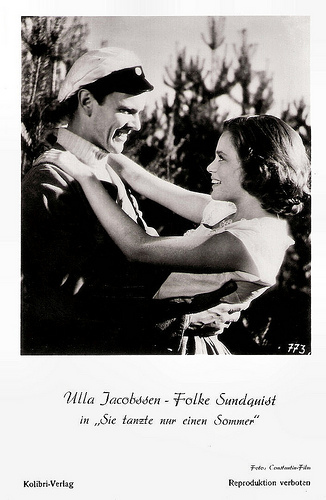
German postcard by Kolibri-Verlag, no. 773. Photo: Constantin-Film. Publicity still for Hon dansade en sommar/One Summer of Happiness (Arne Mattsson, 1951) with Ulla Jacobsson .
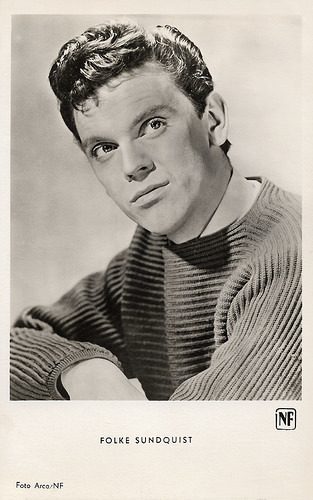
German postcard by Kunst un Bild, Berlin-Charlottenburg, no. A 870. Photo: NF-Film. Publicity still for För min heta ungdoms skull/For the Sake of My Intemperate Youth (Arne Mattson, 1952).
One Summer of Happiness
Folke Sundquist (sometimes written as Sundqvist) was born in 1925 in Falun in central Sweden. After high school, he decided to become an actor and studied drama at the Göteborgs stadsteater (Göteborg City Theatre) in the early 1940s.
In 1946, he made his stage debut there under the direction of Ingmar Bergman in Caligula by Albert Camus. Bergman directed him there also in his play Dagen slutar tidigt (1947) and several other plays. In 1950, he left Göteborg and joined the troupe of the Malmö stadsteater (Malmö City Theatre).
Sundquist had his international breakthrough with his debut film Hon dansade en sommar/One Summer of Happiness (Arne Mattson, 1951), based on the 1949 novel Sommardansen (The Summer Dance) by Per Olof Ekström. He played the male lead as the young and handsome student Göran who spends a summer on his uncle's farm, where he meets the young farmer's daughter Kerstin ( Ulla Jacobsson ). They instantly fall in love, but Kerstin is ruled by puritanical relatives, so they must hide their love. Their story ends tragically in a motorcycle accident.
Hon dansade en sommar was the first Swedish film to win the Golden Bear at the Berlin International Film Festival, and was also nominated for the Palme d'Or at the 1952 Cannes Film Festival. The film was banned in several countries, because of a nude swimming sequence and a love scene with a close-up of Ulla Jacobsson's breasts, but also because of its anti-clerical message by portraying a local priest as the main villain.
Sundquist also starred in the next films by Arne Mattson, För min heta ungdoms skull/For the Sake of My Intemperate Youth (Arne Mattsson, 1952) with Maj-Britt Nilsson and Aino Taube , which was entered into the 1953 Cannes Film Festival, and the war drama Kärlekens bröd/Bread of Love (Arne Mattsson, 1953) with Georg Rydeberg, which again was entered into the 1954 Cannes Film Festival. He also made with Mattson the coming of age story Salka Valka (Arne Mattson, 1954).
In Germany, he made Die Toteninsel/The island of the dead (Victor Tourjansly, 1955) with Willy Birgel and Inge Egger . He also appeared in Ingmar Bergman’s classic Smultronstället/Wild Strawberries (Ingmar Bergman, 1957) starring Victor Sjöström in his final screen performance as a grouchy, stubborn and egotistical professor recalling his past, as well as Bergman regulars Bibi Andersson, Ingrid Thulin and Gunnar Björnstrand.
Hal Erickson at AllMovie : “This classic art movie remains one of Bergman's most accessible films and one of the most influential European art movies of its generation. Its intense focus on one man's thoughts, regrets, and memories set the tone for innumerable psychological character studies in its wake.” Sundquist also appeared in Berman’s TV dramas Venetianskan/The Venetian (Ingmar Bergman, 1958) with Maud Hansson and Gunnel Lindblom, and Rabies (Ingmar Bergman, 1958) with Max von Sydow and Bibi Andersson.
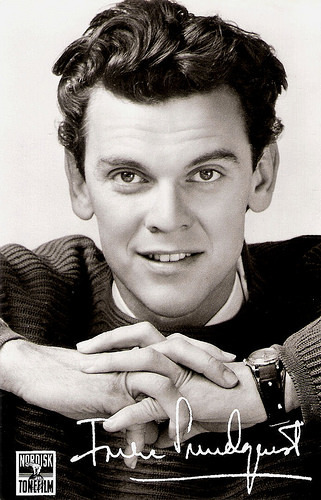
Swedish autograph card by Nordisk Tonefilm.
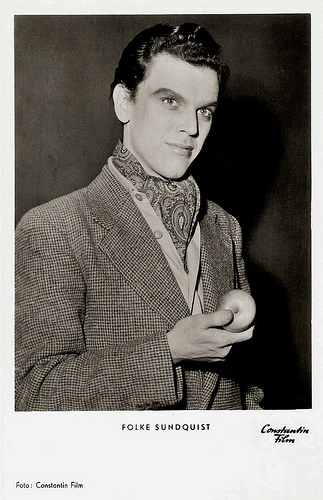
German postcard by Kunst un Bild, Berlin-Charlottenburg, no. A 668. Photo: Constantin Film. Publicity still for Hon dansade en sommar/One Summer of Happiness (Arne Mattson, 1951).
Hour of the Wolf
During the 1960s, Folke Sundquist’s film career slowed down. He appeared opposite Harriet Andersson and Mai Zetterling in Lianbron/The Vine Bridge (1965), directed by famous director of photography Sven Nykvist.
In 1968, he reunited with Ingmar Bergman for a small part in the surrealist–psychological horror–drama Vargtimmen/Hour of the Wolf (Ingmar Bergman, 1968), starring Max von Sydow and Liv Ullmann. Wikipedia : “Although Hour of the Wolf is seldom listed among Bergman's major works by critics, it was ranked one of the 50 greatest films ever made in a 2012 directors' poll by the British Film Institute.”
Sundquist’s final film was Bamse/My Father's Mistress (1968), a reunion with Arne Mattson and Ulla Jacobsson . He played Christer Berg, who dies in a car crash and is found with a teddy bear named ‘Bamse’. His son, also named Christer (Björn Thambert) finds out that Bamse belongs to his father's lover Barbro Persson ( Ulla Jacobsson ). He tries to humiliate her, introducing her to his mother as his new fiancee. But he ends up falling in love with her, and she sees in him the memories of her dead lover.
Apart from his film career, Sundquist also appeared in the theatre during the 1950s and 1960s. From 1950, Sundquist was active at the Malmö stadsteater (Malmö City Theatre). For more than thirty years, he established himself there as one of the best actors in his country in such plays as William Shakespeare's 'Twelfth Night and As you like it. After his film career ended he continued to act on stage in Malmö, where he appeared in plays by such diverse authors as Jean Anouilh, Witold Gombrowicz, Georges Feydeau, Arthur Miller and Molière. He was also an excellent singer and starred in the musicals Irma La Douce and My Fair Lady. In the 1970s and 1980s he directed plays by authors like August Strindberg, Henrik Ibsen and Jean-Paul Sartre.
In 1983, Sundquist finished his successful career and moved to Greece to devote his years to humanitarian work. Later, he returned to Malmö and fell ill. Folke Sundquist died in 2009 in Malmö, Sweden. He was 83.

German collectors card. Photo: Constantin-Film. Publicity still for Hon dansade en sommar/One Summer of Happiness (Arne Mattsson, 1951).
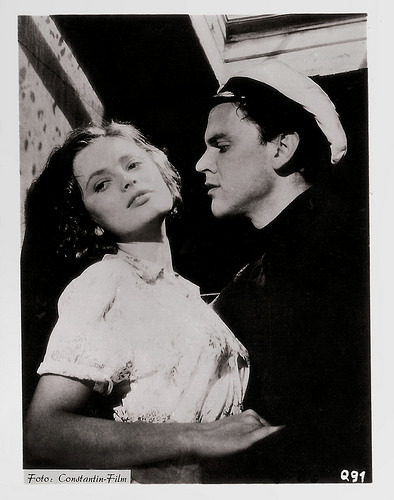
German collectors card. Photo: Constantin-Film. Publicity still for Hon dansade en sommar/One Summer of Happiness (Arne Mattsson, 1951).
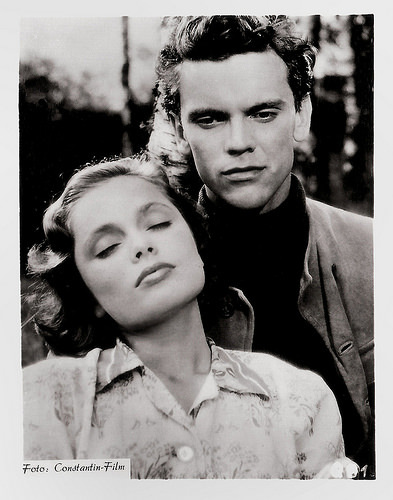
German collectors card. Photo: Constantin-Film. Publicity still for Hon dansade en sommar/One Summer of Happiness (Arne Mattsson, 1951).
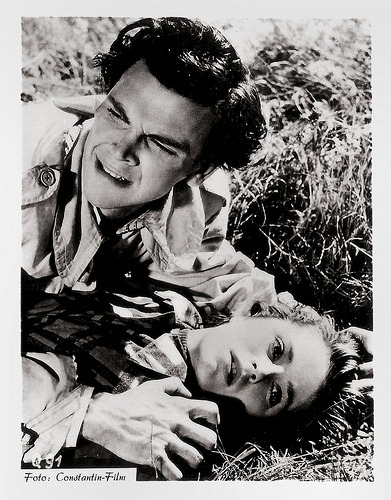
German collectors card. Photo: Constantin-Film. Publicity still for Hon dansade en sommar/One Summer of Happiness (Arne Mattsson, 1951).
Sources: Philippe Pelletier (CinéArtistes – French), Hal Erickson (AllMovie), Tony Kaplan (Expressen - Swedish), Wikipedia and .

German postcard by Kolibri-Verlag, no. 773. Photo: Constantin-Film. Publicity still for Hon dansade en sommar/One Summer of Happiness (Arne Mattsson, 1951) with Ulla Jacobsson .

German postcard by Kunst un Bild, Berlin-Charlottenburg, no. A 870. Photo: NF-Film. Publicity still for För min heta ungdoms skull/For the Sake of My Intemperate Youth (Arne Mattson, 1952).
One Summer of Happiness
Folke Sundquist (sometimes written as Sundqvist) was born in 1925 in Falun in central Sweden. After high school, he decided to become an actor and studied drama at the Göteborgs stadsteater (Göteborg City Theatre) in the early 1940s.
In 1946, he made his stage debut there under the direction of Ingmar Bergman in Caligula by Albert Camus. Bergman directed him there also in his play Dagen slutar tidigt (1947) and several other plays. In 1950, he left Göteborg and joined the troupe of the Malmö stadsteater (Malmö City Theatre).
Sundquist had his international breakthrough with his debut film Hon dansade en sommar/One Summer of Happiness (Arne Mattson, 1951), based on the 1949 novel Sommardansen (The Summer Dance) by Per Olof Ekström. He played the male lead as the young and handsome student Göran who spends a summer on his uncle's farm, where he meets the young farmer's daughter Kerstin ( Ulla Jacobsson ). They instantly fall in love, but Kerstin is ruled by puritanical relatives, so they must hide their love. Their story ends tragically in a motorcycle accident.
Hon dansade en sommar was the first Swedish film to win the Golden Bear at the Berlin International Film Festival, and was also nominated for the Palme d'Or at the 1952 Cannes Film Festival. The film was banned in several countries, because of a nude swimming sequence and a love scene with a close-up of Ulla Jacobsson's breasts, but also because of its anti-clerical message by portraying a local priest as the main villain.
Sundquist also starred in the next films by Arne Mattson, För min heta ungdoms skull/For the Sake of My Intemperate Youth (Arne Mattsson, 1952) with Maj-Britt Nilsson and Aino Taube , which was entered into the 1953 Cannes Film Festival, and the war drama Kärlekens bröd/Bread of Love (Arne Mattsson, 1953) with Georg Rydeberg, which again was entered into the 1954 Cannes Film Festival. He also made with Mattson the coming of age story Salka Valka (Arne Mattson, 1954).
In Germany, he made Die Toteninsel/The island of the dead (Victor Tourjansly, 1955) with Willy Birgel and Inge Egger . He also appeared in Ingmar Bergman’s classic Smultronstället/Wild Strawberries (Ingmar Bergman, 1957) starring Victor Sjöström in his final screen performance as a grouchy, stubborn and egotistical professor recalling his past, as well as Bergman regulars Bibi Andersson, Ingrid Thulin and Gunnar Björnstrand.
Hal Erickson at AllMovie : “This classic art movie remains one of Bergman's most accessible films and one of the most influential European art movies of its generation. Its intense focus on one man's thoughts, regrets, and memories set the tone for innumerable psychological character studies in its wake.” Sundquist also appeared in Berman’s TV dramas Venetianskan/The Venetian (Ingmar Bergman, 1958) with Maud Hansson and Gunnel Lindblom, and Rabies (Ingmar Bergman, 1958) with Max von Sydow and Bibi Andersson.

Swedish autograph card by Nordisk Tonefilm.

German postcard by Kunst un Bild, Berlin-Charlottenburg, no. A 668. Photo: Constantin Film. Publicity still for Hon dansade en sommar/One Summer of Happiness (Arne Mattson, 1951).
Hour of the Wolf
During the 1960s, Folke Sundquist’s film career slowed down. He appeared opposite Harriet Andersson and Mai Zetterling in Lianbron/The Vine Bridge (1965), directed by famous director of photography Sven Nykvist.
In 1968, he reunited with Ingmar Bergman for a small part in the surrealist–psychological horror–drama Vargtimmen/Hour of the Wolf (Ingmar Bergman, 1968), starring Max von Sydow and Liv Ullmann. Wikipedia : “Although Hour of the Wolf is seldom listed among Bergman's major works by critics, it was ranked one of the 50 greatest films ever made in a 2012 directors' poll by the British Film Institute.”
Sundquist’s final film was Bamse/My Father's Mistress (1968), a reunion with Arne Mattson and Ulla Jacobsson . He played Christer Berg, who dies in a car crash and is found with a teddy bear named ‘Bamse’. His son, also named Christer (Björn Thambert) finds out that Bamse belongs to his father's lover Barbro Persson ( Ulla Jacobsson ). He tries to humiliate her, introducing her to his mother as his new fiancee. But he ends up falling in love with her, and she sees in him the memories of her dead lover.
Apart from his film career, Sundquist also appeared in the theatre during the 1950s and 1960s. From 1950, Sundquist was active at the Malmö stadsteater (Malmö City Theatre). For more than thirty years, he established himself there as one of the best actors in his country in such plays as William Shakespeare's 'Twelfth Night and As you like it. After his film career ended he continued to act on stage in Malmö, where he appeared in plays by such diverse authors as Jean Anouilh, Witold Gombrowicz, Georges Feydeau, Arthur Miller and Molière. He was also an excellent singer and starred in the musicals Irma La Douce and My Fair Lady. In the 1970s and 1980s he directed plays by authors like August Strindberg, Henrik Ibsen and Jean-Paul Sartre.
In 1983, Sundquist finished his successful career and moved to Greece to devote his years to humanitarian work. Later, he returned to Malmö and fell ill. Folke Sundquist died in 2009 in Malmö, Sweden. He was 83.

German collectors card. Photo: Constantin-Film. Publicity still for Hon dansade en sommar/One Summer of Happiness (Arne Mattsson, 1951).

German collectors card. Photo: Constantin-Film. Publicity still for Hon dansade en sommar/One Summer of Happiness (Arne Mattsson, 1951).

German collectors card. Photo: Constantin-Film. Publicity still for Hon dansade en sommar/One Summer of Happiness (Arne Mattsson, 1951).

German collectors card. Photo: Constantin-Film. Publicity still for Hon dansade en sommar/One Summer of Happiness (Arne Mattsson, 1951).
Sources: Philippe Pelletier (CinéArtistes – French), Hal Erickson (AllMovie), Tony Kaplan (Expressen - Swedish), Wikipedia and .
Published on March 02, 2018 22:00
March 1, 2018
Kunst und Bild
Since 1930 Kunst und Bild (Art and Image) or KuB is one of Germany's leading publishers of postal and greeting cards. During the 1950s, the Berlin company published many film star postcards, often in black and white and with a white frame. The company still exists today but KuB's collection contains no more film star postcards.
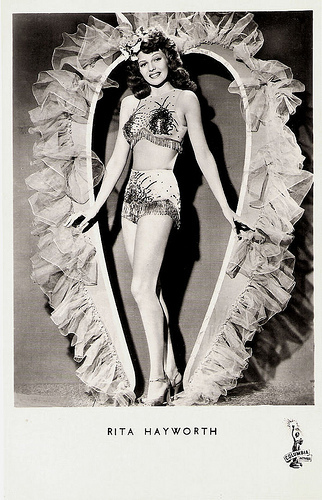
Rita Hayworth . German postcard by Kunst und Bild, Berlin, no. A 124. Photo: Columbia.
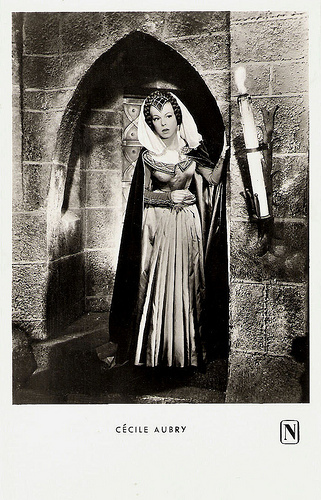
Cécile Aubry. German postcard by Kunst und Bild, Berlin, no. A 410. Photo: publicity still for Barbe-Bleue/Bluebeard (Christian-Jaque, 1951).
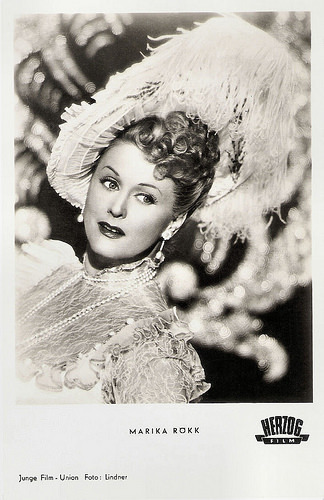
Marika Rökk . German postcard by Kunst und Bild, Berlin, no. A 478. Photo: Herzog-Film / Junge Film-Union / Lindner. Publicity still for Die Casardasfürstin/The Csardas Princess (Georg Jacoby, 1951).
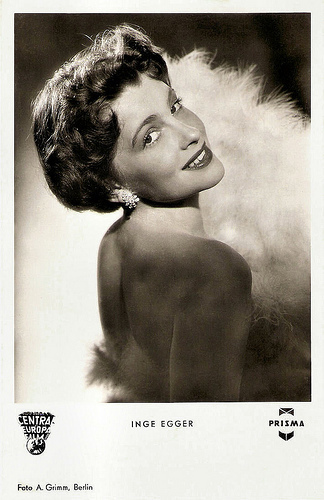
Inge Egger . German postcard by Kunst und Bild, Berlin, no. A 804. Photo: Central-Europa / Prisma / A. Grimm. Publicity still for Die Rose von Stambul/The Rose of Stambul (Karl Anton, 1953).
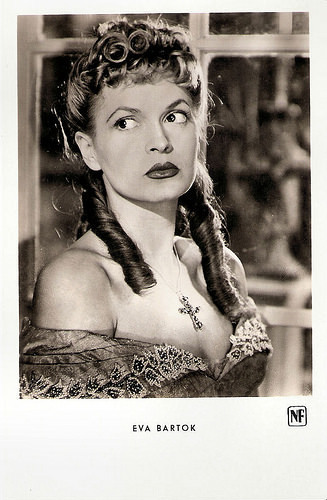
Eva Bartok. German postcard by Kunst und Bild, Berlin, no. A 853. Photo: NF. Publicity still for Der letzte Walzer/The Last Waltz (Arthur Maria Rabenalt, 1953).

Debra Paget . German postcard by Kunst und Bild, Berlin, no. A 964. Photo: 20th Century Fox.
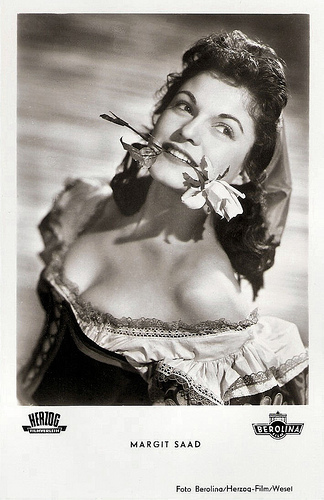
Margit Saad . German postcard by Kunst und Bild, Berlin, no. A 1128. Photo: Herzog / Berolina. Publicity still for Der Zigeunerbaron/Baron Tzigane/Gypsy Baron (Arthur Maria Rabenalt, 1954).
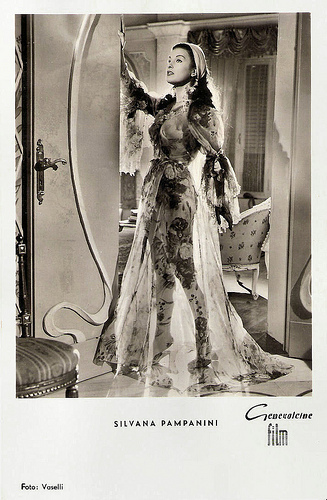
Silvana Pampanini . German postcard by Kunst und Bild, Berlin. Photo: Generalcine Film / Vaselli.
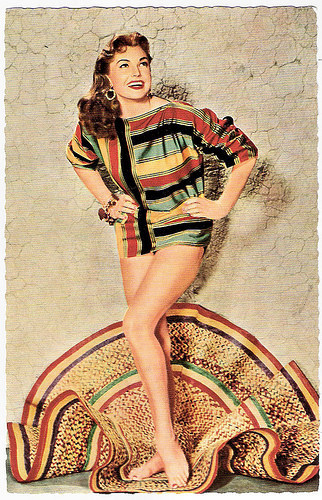
Esther Williams. German postcard by Kunst und Bild, no. C D 2.
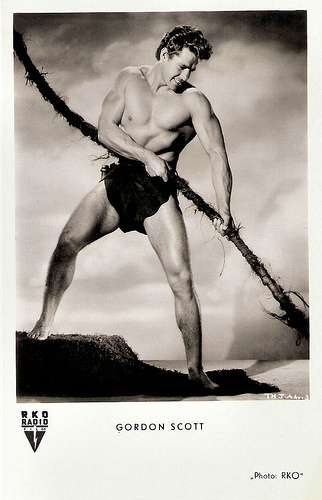
Gordon Scott . German postcard by Kunst und Bild, no. I 411. Photo: RKO. Publicity still for Tarzan's Hidden Jungle (Harold D. Schuster, 1955).
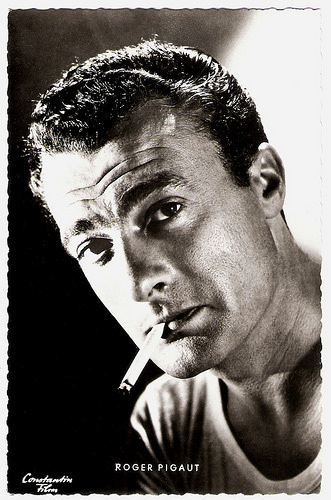
Roger Pigaut . German postcard by Kunst und Bild, Berlin, no. I 477. Photo: EGC / Fernand Rivers / Constantin Film. Publicity still for La Lumière d'en face/Female and the Flesh (Georges Lacombe, 1955).
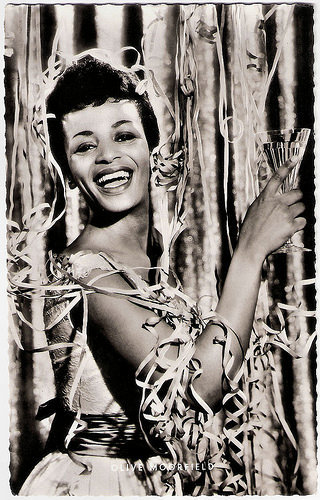
Olive Moorefield . German postcard by Kunst und Bild, Berlin-Charlottenburg, no. V 172. Photo: Kurt-Ulrich-Film / Constantin / Wesel. Publicity still for Die Beine von Dolores/The legs of Dolores (Géza von Cziffra, 1957).
You'll find more film star postcards by Kunst und Bild in our album Kunst und Bild at Flickr.
Source: Kunst und Bild (German).

Rita Hayworth . German postcard by Kunst und Bild, Berlin, no. A 124. Photo: Columbia.

Cécile Aubry. German postcard by Kunst und Bild, Berlin, no. A 410. Photo: publicity still for Barbe-Bleue/Bluebeard (Christian-Jaque, 1951).

Marika Rökk . German postcard by Kunst und Bild, Berlin, no. A 478. Photo: Herzog-Film / Junge Film-Union / Lindner. Publicity still for Die Casardasfürstin/The Csardas Princess (Georg Jacoby, 1951).

Inge Egger . German postcard by Kunst und Bild, Berlin, no. A 804. Photo: Central-Europa / Prisma / A. Grimm. Publicity still for Die Rose von Stambul/The Rose of Stambul (Karl Anton, 1953).

Eva Bartok. German postcard by Kunst und Bild, Berlin, no. A 853. Photo: NF. Publicity still for Der letzte Walzer/The Last Waltz (Arthur Maria Rabenalt, 1953).

Debra Paget . German postcard by Kunst und Bild, Berlin, no. A 964. Photo: 20th Century Fox.

Margit Saad . German postcard by Kunst und Bild, Berlin, no. A 1128. Photo: Herzog / Berolina. Publicity still for Der Zigeunerbaron/Baron Tzigane/Gypsy Baron (Arthur Maria Rabenalt, 1954).

Silvana Pampanini . German postcard by Kunst und Bild, Berlin. Photo: Generalcine Film / Vaselli.

Esther Williams. German postcard by Kunst und Bild, no. C D 2.

Gordon Scott . German postcard by Kunst und Bild, no. I 411. Photo: RKO. Publicity still for Tarzan's Hidden Jungle (Harold D. Schuster, 1955).

Roger Pigaut . German postcard by Kunst und Bild, Berlin, no. I 477. Photo: EGC / Fernand Rivers / Constantin Film. Publicity still for La Lumière d'en face/Female and the Flesh (Georges Lacombe, 1955).

Olive Moorefield . German postcard by Kunst und Bild, Berlin-Charlottenburg, no. V 172. Photo: Kurt-Ulrich-Film / Constantin / Wesel. Publicity still for Die Beine von Dolores/The legs of Dolores (Géza von Cziffra, 1957).
You'll find more film star postcards by Kunst und Bild in our album Kunst und Bild at Flickr.
Source: Kunst und Bild (German).
Published on March 01, 2018 22:00
February 28, 2018
Daniel Craig
Blonde and blue-eyes English actor Daniel Craig (1968) is best known as the sixth James Bond. He appeared as the British secret agent in Casino Royale (2006), Quantum of Solace (2008), Skyfall (2012) and Spectre (2015). He also appeared in such great films as Love Is the Devil: Study for a Portrait of Francis Bacon (1998), the crime thriller Road to Perdition (2002), and the historical drama Munich (2005).
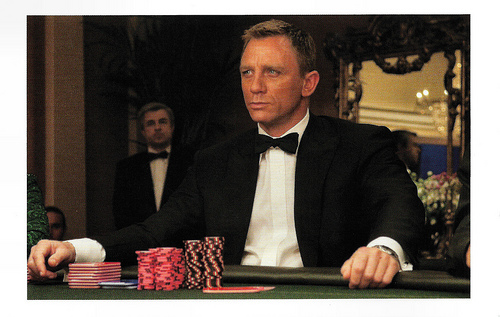
British postcard by EON Productions. Photo: Danjaq / LLC / United Artists Corporation / Columbia Pictures Ind.. Publicity still for Casino Royale (Martin Campbell, 2006).
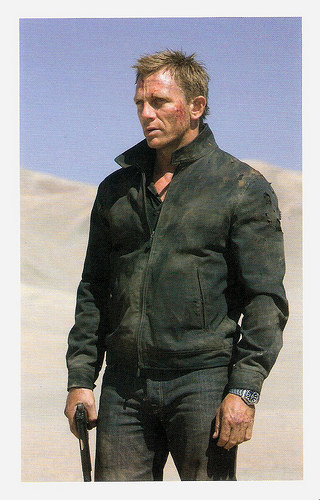
British postcard by EON Productions. Photo: Danjaq / LLC / United Artists Corporation / Columbia Pictures Ind. Publicity still for Quantum of Solace (Marc Forster, 2008).
Love is the Devil
Daniel Wroughton Craig was born in 1968 in Chester, Cheshire. His mother, Carol Olivia (née Williams), was an art teacher, and his father, Timothy John Wroughton Craig, was the landlord of two pubs. When his parents divorced, Craig and his older sister Lea lived with their mother, moving to Liverpool, and later to Hoylake, Wirral.
Craig began acting in school plays at the age of six, and was introduced to serious acting by attending the Everyman Theatre in nearby Liverpool City Centre with his mother. He was also a good athlete and was a rugby player at Hoylake Rugby Club. At 16, he started to train at the National Youth Theatre and graduated from the Guildhall School of Music and Drama in 1991, before beginning his career on stage.
In 1992, Craig married Scottish actress Fiona Loudon, with whom he has a daughter Ella Craig (1992). The marriage ended in divorce in 1994. After his divorce, he was in a seven-year relationship with German actress Heike Makatsch, ending in 2001. He subsequently dated and was engaged to film producer Satsuki Mitchell from 2005 until 2010.
His film debut was as an Afrikaner in the drama The Power of One (John G. Avildsen, 1992). He then appeared as closeted gay Mormon and Republican Joe Pitt in the Royal National Theatre's production of Tony Kushner's Angels in America in November 1993. Other early film appearances were in the Disney family film A Kid in King Arthur's Court (Michael Gottlieb, 1995) and the biographical film Elizabeth (Shekhar Kapur, 1998) featuring Cate Blanchett.
Craig's appearances in the British television film Love Is the Devil: Study for a Portrait of Francis Bacon (John Maybury, 1998) with Derek Jacobi, the indie war film The Trench (William Boyd, 1999), and the drama Some Voices (Simon Cellan Jones, 2000) attracted the film industry's attention.
This led to roles in bigger productions such as the action film Lara Croft: Tomb Raider (Simon West, 2001) - as Angelina Jolie's rival and love interest, the crime thriller Road to Perdition (Sam Mendes, 2002) with Tom Hanks and Paul Newman, the crime thriller Layer Cake (Matthew Vaughn, 2004), The Jacket (John Maybury, 2005), and the historical drama Munich (Steven Spielberg, 2005).
Smaller but also interesting were The Mother (Roger Michell, 2003) in which he played the lover of the much older Anne Reid, and Infamous (Douglas McGrath, 2006), in which he played murderer Perry Smith who became the subject for Truman Capote’s classic novel In Cold Blood.
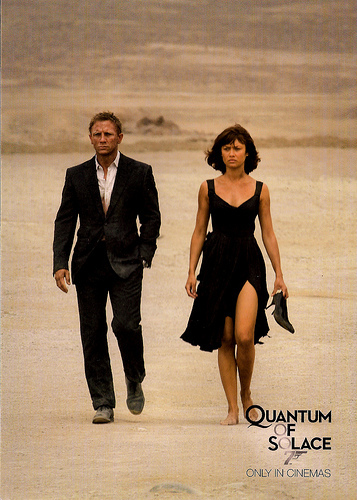
British postcard by Peek & Cloppenburg, Col.-no. 198. Photo: Danjaq / LLC / United Artists Corporation / Columbia Pictures Ind. Publicity still for Quantum of Solace (Marc Forster, 2008) with Olga Kurylenko.
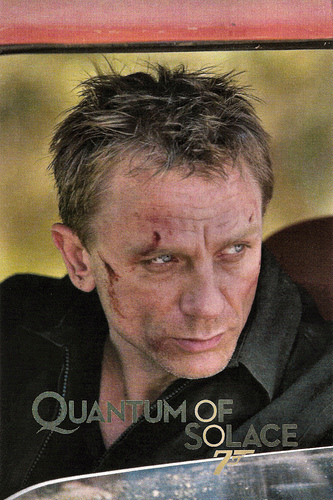
Chinese postcard by Oriental City Publishing Group Limited. Photo: publicity still for Quantum of Solace (Marc Forster, 2008).
The sixth 007Daniel Craig achieved international fame when chosen as the sixth actor to play the role of Ian Fleming's James Bond in the official film series, taking over from Pierce Brosnan in 2005. Reportedly, he quit smoking and gained twenty pounds of muscle for the part. Although his casting was initially greeted with scepticism, his debut was highly acclaimed and earned him a BAFTA award nomination. Casino Royale (Martin Campbell, 2006) became the highest-grossing in the series at the time.
Steve Sholokhonov at IMDb : “Craig's reserved demeanor and his avoidance of the showbiz-party-red-carpet milieu makes him a cool 007. He is the first blond actor to play Bond, and also the first to be born after the start of the film series, and also the first to be born after the death of author Ian Fleming in 1964. Four of the past Bond actors: Sean Connery , Roger Moore , Timothy Dalton and Pierce Brosnan have indicated that Craig is a good choice as Bond.”
Two years later followed Quantum of Solace (Marc Forster, 2008). Craig's third Bond film, Skyfall (Sam Mendes, 2012) with Javier Bardem and Ralph Fiennes, was the highest-grossing film in the UK until 2015 and the fifteenth highest-grossing film of all time. Craig's fourth Bond film was Spectre (Sam Mendes, 2015) with Christoph Waltz and Monica Bellucci .
Since taking the role of Bond, he has continued to star in other films, including the World War II film Defiance (Edward Zwick, 2008) and the Science Fiction Western Cowboys & Aliens (Jon Favreau, 2011) with Harrison Ford. He starred as crusading journalist Mikael Blomkvist in the English-language adaptation of Stieg Larsson's mystery thriller The Girl with the Dragon Tattoo (David Fincher, 2011).
In 2011, he also starred in the psychological thriller Dream House (Jim Sheridan, 2011) co-starring his second wife Rachel Weisz and Naomi Watts. Craig also made a guest appearance as James Bond in the opening ceremony of the London 2012 Olympic Games, alongside Queen Elizabeth II. In 2014, he and his wife Weisz starred on Broadway in Harold Pinter’s play Betrayal. Despite mixed reviews, it grossed $17.5 million, becoming the second highest Broadway play of 2013.
Craig did an uncredited cameo in Star Wars: Episode VII - The Force Awakens (J.J. Abrams, 2015) as the stormtrooper on whom Rey (Daisy Ridley) performs a Jedi mind trick. Recently he starred in Steven Soderbergh's heist film Logan Lucky (2017) starring Channing Tatum.
On the 15 August 2017 episode of The Late Show with Stephen Colbert, Craig publicly confirmed that he will return to his role as James Bond. His four Bond films released by Sony has earned a combined gross of $3.5 billion globally, after adjusting for inflation. Craig has described his portrayal of Bond as an anti-hero: "The question I keep asking myself while playing the role is, 'Am I the good guy or just a bad guy who works for the good side?' Bond's role, after all, is that of an assassin when you come down to it. I have never played a role in which someone's dark side shouldn't be explored. I don't think it should be confusing by the end of the film, but during the film you should be questioning who he is."
When it was confirmed that Craig would play 007 again in 2019 Daniel Craig officially became the longest-serving James Bond.

Chinese postcard. Photo: publicity still for The Golden Compass (Chris Weitz, 2007).
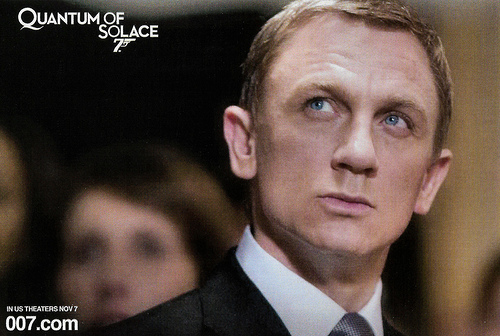
Chinese postcard by Oriental City Publishing Group Limited. Photo: publicity still for Quantum of Solace (Marc Forster, 2008).
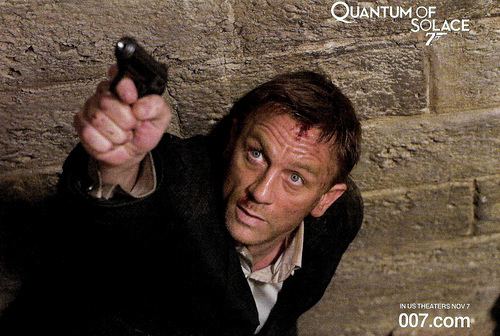
Chinese postcard by Oriental City Publishing Group Limited. Photo: publicity still for Quantum of Solace (Marc Forster, 2008).
Sources: (IMDb), Wikipedia and .

British postcard by EON Productions. Photo: Danjaq / LLC / United Artists Corporation / Columbia Pictures Ind.. Publicity still for Casino Royale (Martin Campbell, 2006).

British postcard by EON Productions. Photo: Danjaq / LLC / United Artists Corporation / Columbia Pictures Ind. Publicity still for Quantum of Solace (Marc Forster, 2008).
Love is the Devil
Daniel Wroughton Craig was born in 1968 in Chester, Cheshire. His mother, Carol Olivia (née Williams), was an art teacher, and his father, Timothy John Wroughton Craig, was the landlord of two pubs. When his parents divorced, Craig and his older sister Lea lived with their mother, moving to Liverpool, and later to Hoylake, Wirral.
Craig began acting in school plays at the age of six, and was introduced to serious acting by attending the Everyman Theatre in nearby Liverpool City Centre with his mother. He was also a good athlete and was a rugby player at Hoylake Rugby Club. At 16, he started to train at the National Youth Theatre and graduated from the Guildhall School of Music and Drama in 1991, before beginning his career on stage.
In 1992, Craig married Scottish actress Fiona Loudon, with whom he has a daughter Ella Craig (1992). The marriage ended in divorce in 1994. After his divorce, he was in a seven-year relationship with German actress Heike Makatsch, ending in 2001. He subsequently dated and was engaged to film producer Satsuki Mitchell from 2005 until 2010.
His film debut was as an Afrikaner in the drama The Power of One (John G. Avildsen, 1992). He then appeared as closeted gay Mormon and Republican Joe Pitt in the Royal National Theatre's production of Tony Kushner's Angels in America in November 1993. Other early film appearances were in the Disney family film A Kid in King Arthur's Court (Michael Gottlieb, 1995) and the biographical film Elizabeth (Shekhar Kapur, 1998) featuring Cate Blanchett.
Craig's appearances in the British television film Love Is the Devil: Study for a Portrait of Francis Bacon (John Maybury, 1998) with Derek Jacobi, the indie war film The Trench (William Boyd, 1999), and the drama Some Voices (Simon Cellan Jones, 2000) attracted the film industry's attention.
This led to roles in bigger productions such as the action film Lara Croft: Tomb Raider (Simon West, 2001) - as Angelina Jolie's rival and love interest, the crime thriller Road to Perdition (Sam Mendes, 2002) with Tom Hanks and Paul Newman, the crime thriller Layer Cake (Matthew Vaughn, 2004), The Jacket (John Maybury, 2005), and the historical drama Munich (Steven Spielberg, 2005).
Smaller but also interesting were The Mother (Roger Michell, 2003) in which he played the lover of the much older Anne Reid, and Infamous (Douglas McGrath, 2006), in which he played murderer Perry Smith who became the subject for Truman Capote’s classic novel In Cold Blood.

British postcard by Peek & Cloppenburg, Col.-no. 198. Photo: Danjaq / LLC / United Artists Corporation / Columbia Pictures Ind. Publicity still for Quantum of Solace (Marc Forster, 2008) with Olga Kurylenko.

Chinese postcard by Oriental City Publishing Group Limited. Photo: publicity still for Quantum of Solace (Marc Forster, 2008).
The sixth 007Daniel Craig achieved international fame when chosen as the sixth actor to play the role of Ian Fleming's James Bond in the official film series, taking over from Pierce Brosnan in 2005. Reportedly, he quit smoking and gained twenty pounds of muscle for the part. Although his casting was initially greeted with scepticism, his debut was highly acclaimed and earned him a BAFTA award nomination. Casino Royale (Martin Campbell, 2006) became the highest-grossing in the series at the time.
Steve Sholokhonov at IMDb : “Craig's reserved demeanor and his avoidance of the showbiz-party-red-carpet milieu makes him a cool 007. He is the first blond actor to play Bond, and also the first to be born after the start of the film series, and also the first to be born after the death of author Ian Fleming in 1964. Four of the past Bond actors: Sean Connery , Roger Moore , Timothy Dalton and Pierce Brosnan have indicated that Craig is a good choice as Bond.”
Two years later followed Quantum of Solace (Marc Forster, 2008). Craig's third Bond film, Skyfall (Sam Mendes, 2012) with Javier Bardem and Ralph Fiennes, was the highest-grossing film in the UK until 2015 and the fifteenth highest-grossing film of all time. Craig's fourth Bond film was Spectre (Sam Mendes, 2015) with Christoph Waltz and Monica Bellucci .
Since taking the role of Bond, he has continued to star in other films, including the World War II film Defiance (Edward Zwick, 2008) and the Science Fiction Western Cowboys & Aliens (Jon Favreau, 2011) with Harrison Ford. He starred as crusading journalist Mikael Blomkvist in the English-language adaptation of Stieg Larsson's mystery thriller The Girl with the Dragon Tattoo (David Fincher, 2011).
In 2011, he also starred in the psychological thriller Dream House (Jim Sheridan, 2011) co-starring his second wife Rachel Weisz and Naomi Watts. Craig also made a guest appearance as James Bond in the opening ceremony of the London 2012 Olympic Games, alongside Queen Elizabeth II. In 2014, he and his wife Weisz starred on Broadway in Harold Pinter’s play Betrayal. Despite mixed reviews, it grossed $17.5 million, becoming the second highest Broadway play of 2013.
Craig did an uncredited cameo in Star Wars: Episode VII - The Force Awakens (J.J. Abrams, 2015) as the stormtrooper on whom Rey (Daisy Ridley) performs a Jedi mind trick. Recently he starred in Steven Soderbergh's heist film Logan Lucky (2017) starring Channing Tatum.
On the 15 August 2017 episode of The Late Show with Stephen Colbert, Craig publicly confirmed that he will return to his role as James Bond. His four Bond films released by Sony has earned a combined gross of $3.5 billion globally, after adjusting for inflation. Craig has described his portrayal of Bond as an anti-hero: "The question I keep asking myself while playing the role is, 'Am I the good guy or just a bad guy who works for the good side?' Bond's role, after all, is that of an assassin when you come down to it. I have never played a role in which someone's dark side shouldn't be explored. I don't think it should be confusing by the end of the film, but during the film you should be questioning who he is."
When it was confirmed that Craig would play 007 again in 2019 Daniel Craig officially became the longest-serving James Bond.

Chinese postcard. Photo: publicity still for The Golden Compass (Chris Weitz, 2007).

Chinese postcard by Oriental City Publishing Group Limited. Photo: publicity still for Quantum of Solace (Marc Forster, 2008).

Chinese postcard by Oriental City Publishing Group Limited. Photo: publicity still for Quantum of Solace (Marc Forster, 2008).
Sources: (IMDb), Wikipedia and .
Published on February 28, 2018 22:00
February 27, 2018
Das Maskenfest des Lebens (1918)
Henny Porten and Bruno Decarli are the stars of the German silent drama Das Maskenfest des Lebens/The Masquerade of Life (Rudolf Biebrach, 1918). It was produced by Messter Film. Rotophot produced a postcard series of the film in their Film Sterne series.
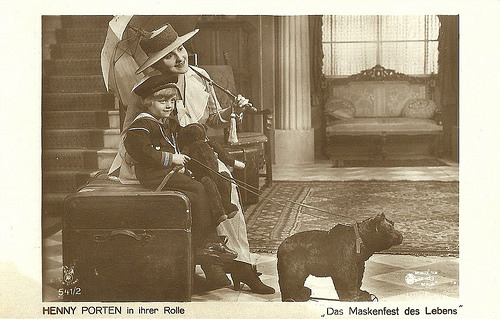
German postcard in the Film Sterne series by Rotophot, no. 541/2. Photo: Messter-Film. Henny Porten and Walfried Mellin in Das Maskenfest des Lebens (Rudolf Biebrach 1918).
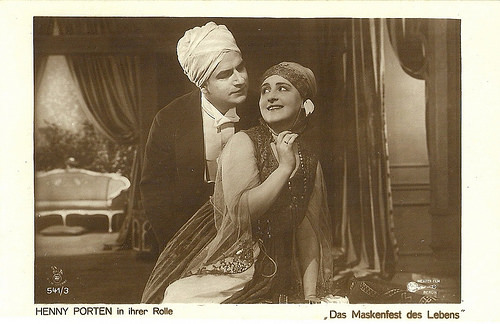
German postcard in the Film Sterne series by Rotophot, no. 541/3. Photo: Messter-Film. Henny Porten and Bruno Decarli in Das Maskenfest des Lebens (Rudolf Biebrach 1918).
A Mysterious Stranger
In Das Maskenfest des Lebens/The Masquerade of Life (Rudolf Biebrach, 1918), Henny Porten plays Jolanthe von Brissac, the lady-in-waiting of a Grand Duchess (Olga Engl). She wants Jolanthe to marry Count Falken (Ernst Wendt), although Jolanthe does not love him.
After a short marriage, the count dies when deadly injured in a hunt. A little later Jolanthe gets to know another man during a dance, who does not show himself, since he is wearing a mask at that time.
Jolanthe is fascinated by this mysterious stranger, invites him to a cup of tea and finally gives herself to him. She does not suspect that the mysterious stranger is doctor Wolfgang Sanders ( Bruno Decarli ).
As a result of this one-night stand, a child is born. Jolanthe's son is four years old when he becomes seriously ill one day. Worried, his mother immediately calls a doctor to look after her little Rolf (Walfried Mellin) and save his life. Only now does Jolanthe realise that the doctor is her great love and at the same time the father of her child. Happy end.
The script by Wilhelm Roelinghoff was liberally based on a novel by Honoré de Balzac. Das Maskenfest des Lebens passed censorship in August 1918 and premiered on 30 August 1918 in the cinema Mozartsaal in Berlin. The film had four acts and originally was 1440 meters long, with 75 subtitles. It was banned to youngsters.
In a new censorship in May 1921, the film was cut down to 1213 meters. In the Austrian Paimann’s Filmlisten the film was marked as "Stoff sehr gut, Photos und Szenerie ausgezeichnet." (Subject very good, cinematography and scenery outstanding). Cinematography was by Karl Freund, the later camera wizard of German Expressionist cinema, and the sets were designed by Ludwig Kainer and Jack Winter.
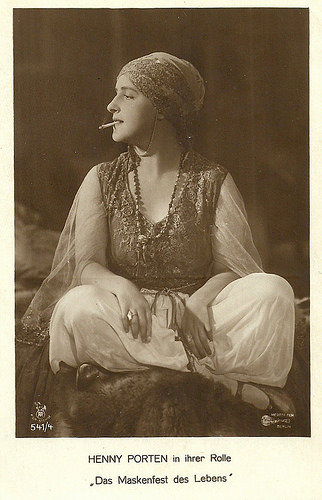
German postcard in the Film Sterne series by Rotophot, no. 541/4. Photo: Messter-Film. Henny Porten in Das Maskenfest des Lebens (Rudolf Biebrach 1918).
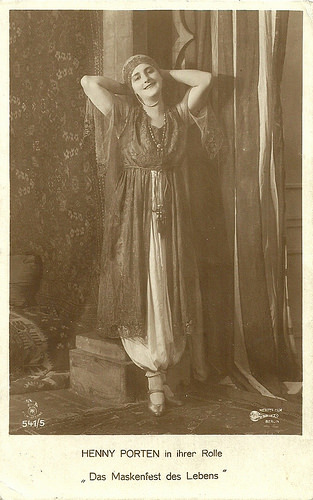
German postcard in the Film Sterne series by Rotophot, no. 541/5. Photo: Messter-Film. Henny Porten in Das Maskenfest des Lebens (Rudolf Biebrach 1918).
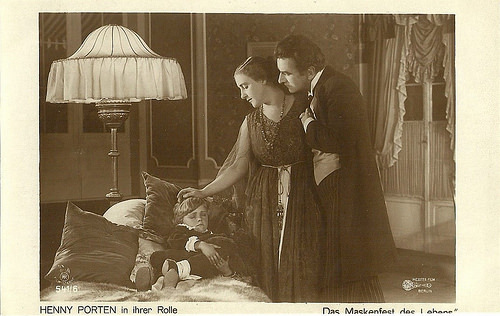
German postcard in the Film Sterne series by Rotophot, no. 541/6. Photo: Messter-Film. Henny Porten , Bruno Decarli and Walfried Mellin in Das Maskenfest des Lebens (Rudolf Biebrach 1918).
Source: Filmportal.de, The German Early Cinema Database, Wikipedia (German) and IMDb.

German postcard in the Film Sterne series by Rotophot, no. 541/2. Photo: Messter-Film. Henny Porten and Walfried Mellin in Das Maskenfest des Lebens (Rudolf Biebrach 1918).

German postcard in the Film Sterne series by Rotophot, no. 541/3. Photo: Messter-Film. Henny Porten and Bruno Decarli in Das Maskenfest des Lebens (Rudolf Biebrach 1918).
A Mysterious Stranger
In Das Maskenfest des Lebens/The Masquerade of Life (Rudolf Biebrach, 1918), Henny Porten plays Jolanthe von Brissac, the lady-in-waiting of a Grand Duchess (Olga Engl). She wants Jolanthe to marry Count Falken (Ernst Wendt), although Jolanthe does not love him.
After a short marriage, the count dies when deadly injured in a hunt. A little later Jolanthe gets to know another man during a dance, who does not show himself, since he is wearing a mask at that time.
Jolanthe is fascinated by this mysterious stranger, invites him to a cup of tea and finally gives herself to him. She does not suspect that the mysterious stranger is doctor Wolfgang Sanders ( Bruno Decarli ).
As a result of this one-night stand, a child is born. Jolanthe's son is four years old when he becomes seriously ill one day. Worried, his mother immediately calls a doctor to look after her little Rolf (Walfried Mellin) and save his life. Only now does Jolanthe realise that the doctor is her great love and at the same time the father of her child. Happy end.
The script by Wilhelm Roelinghoff was liberally based on a novel by Honoré de Balzac. Das Maskenfest des Lebens passed censorship in August 1918 and premiered on 30 August 1918 in the cinema Mozartsaal in Berlin. The film had four acts and originally was 1440 meters long, with 75 subtitles. It was banned to youngsters.
In a new censorship in May 1921, the film was cut down to 1213 meters. In the Austrian Paimann’s Filmlisten the film was marked as "Stoff sehr gut, Photos und Szenerie ausgezeichnet." (Subject very good, cinematography and scenery outstanding). Cinematography was by Karl Freund, the later camera wizard of German Expressionist cinema, and the sets were designed by Ludwig Kainer and Jack Winter.

German postcard in the Film Sterne series by Rotophot, no. 541/4. Photo: Messter-Film. Henny Porten in Das Maskenfest des Lebens (Rudolf Biebrach 1918).

German postcard in the Film Sterne series by Rotophot, no. 541/5. Photo: Messter-Film. Henny Porten in Das Maskenfest des Lebens (Rudolf Biebrach 1918).

German postcard in the Film Sterne series by Rotophot, no. 541/6. Photo: Messter-Film. Henny Porten , Bruno Decarli and Walfried Mellin in Das Maskenfest des Lebens (Rudolf Biebrach 1918).
Source: Filmportal.de, The German Early Cinema Database, Wikipedia (German) and IMDb.
Published on February 27, 2018 22:00
February 26, 2018
Oscar Marion
Austrian actor Oscar Marion (1894-1986) was a popular star of the German cinema in the silent era and the 1930s. During the 1940s and 1950s, he worked as a production manager.
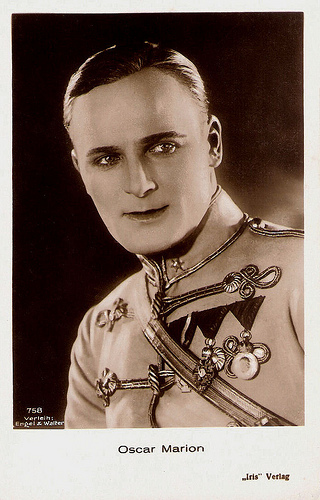
Austrian postcard by Iris Verlag, no. 758. Photo: Verleih Engel & Walter.
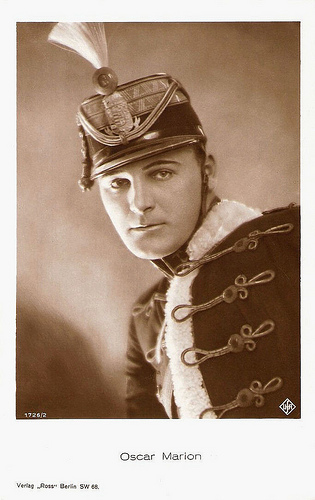
German postcard by Ross Verlag, no. 1726/2, 1927-1928. Photo: Ufa.
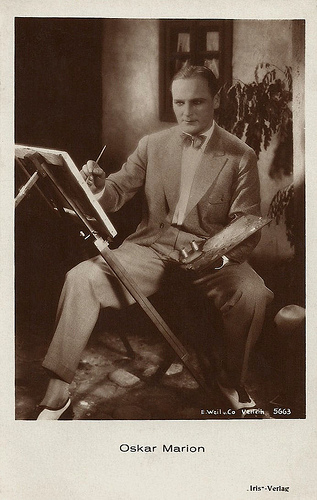
Austrian postcard by Iris Verlag, no. 5663. Photo: E. Weill & Co. Verleih.
Elegant Lover
Oscar Marion (aka Oskar Marion) was born as Oskar Lepka in Brünn in the Austrian-Hungarian Empire (now Brno, Czech Republic) in 1894.
He studied Medicine in Vienna for some semesters and afterwards served as a sanitary during the First World War. After the war he took acting lessons in Vienna and started a stage career at the Wiener Kammerspielen, later on also at the Stadttheater in Brünn and the Landestheater in Prague.
From there he went to Berlin, where he performed in various theatres. From 1919 he was active as actor in the German cinema, often playing the elegant lover and gentleman. In the first half of the 1920s Marion played in countless films, with a record of 18 films in 1920.
Memorable titles are Die Schmugglerin/The smuggler (Eugen Burg, 1920) with Wanda Treumann , Die Glücksfalle/The lucky chance (Arthur Wellin, 1920) with Lotte Neumann , the three-part serial Fortunato (Karl Halden, 1921) with Marion as the impostor Fortunato, Strandgut der Leidenschaft/Flotsam of passion (Jaap Speyer, 1921), and Die rote Nacht/The Red Night (Jaap Speyer, 1921).
In 1922 he appeared in a.o. Die Männer der Frau Clarissa/The Men of Mrs. Clarissa (Fred Sauer, 1922), Die Frau mit den 10 Masken/The Woman with the Ten Masks (Siegfried Dessauer, 1922), Alexandra (Theo Frenkel, 1922) with Margit Barnay, Monna Vanna (Richard Eichberg, 1922) with Lee Parry , and Quarantäne/Quarantine (Max Mack, 1922) with Helena Makowska.
The next years followed such titles as Schande/Shame (Theo Frenkel, 1923) again with Makowska, Die Frau aus dem Orient/The Woman from the Orient (Wolfgang Neff, 1923) with Marion in the lead and Hedda Vernon co-starring, Taras Bulba (Vladimir Strizevskij, 1924) one of Taras Bulba’s sons with again Helena Makowska , Kampf um die Scholle/Struggle for the Soil (Erich Waschneck, 1925), and the part documentary part science fiction film Wunder der Schöpfung/Wonders of Creation (Hans Walter Kornblum, Rudolf Biebrach, Johannes Meyer, 1925).
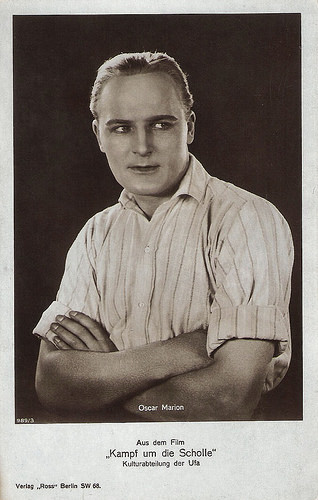
German postcard by Ross Verlag, no. 989/3, 1925-1926. Photo: Ufa. Publicity still for Kampf um die Scholle/Struggle for the Soil (Erich Waschneck, 1925).
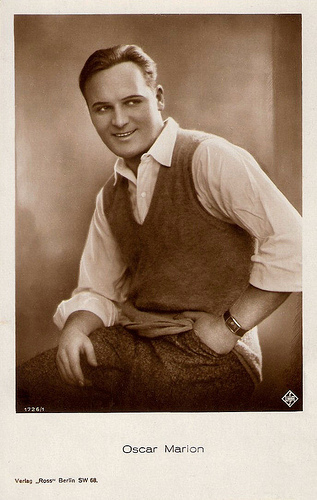
German postcard by Ross Verlag, no. 1726/1, 1927-1928. Photo: Ufa.
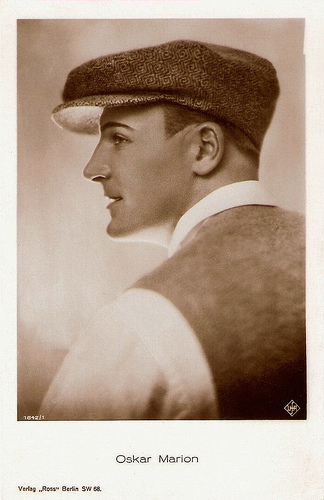
German postcard by Ross Verlag, no. 1642/1, 1927-1928. Photo: Ufa.
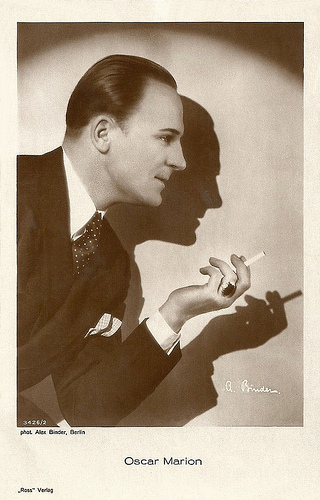
German postcard by Ross Verlag, no. 3426/2, 1928-1929. Photo: Alex Binder, Berlin.
Super production
From the mid-1920s on, the number of films in which Oscar Marion yearly acted became less, but not his reputation. He played in Fedora (Jean Manoussi, 1926) with Lee Parry , Mein Freund, der Chauffeur/My Friend, the driver (Erich Waschneck, 1925), and Die kleine Inge und ihre drei Väter/Little Inge and her three fathers (Franz Osten, 1926).
In 1927, Marion played Prince Edwin in love with czardas dancer Sylva Varescu ( Liane Haid ) in Die Czardasfürstin/The Csardas Queen (Hanns Schwarz, 1927), while he acted again for Dutch director Jaap Speyer as the male lead in Valencia, Du schönste aller Rosen/Valencia, you the most beautiful of all roses (Jaap Speyer, 1927) about a German in love with a Spanish flower seller (Maria Dalbaicin).
Next came films like Sturmflut/Storm tide (Willy Reiber, 1927), Hast du geliebt am schönen Rhein/If you have loved on the beautiful Rhine (James Bauer, 1927), Die Lindenwirtin am Rhein/The lime landlady on the Rhine (Rolf Randolf, 1927) with Maly Delschaft , while Marion had a minor part in the super production Waterloo (Karl Grune, 1928) and a larger part in Andreas Hofer (Hanns Prechtl, 1929), starring Fritz Greiner and again Mady Delschaft .
When sound film came along, Marion worked in both the Czech cinema and the German cinema. In Czechoslovakia he acted for instance in Dobry vojak Svejk/The Good Sioldier Schwejk (1931) - the first sound film version of the adventures of Schwejk. In the sound era Marion also played in films such as Nie wieder Liebe/Never Love Again (Anatole Litvak, 1931) with Lilian Harvey , Henker, Frauen und Soldaten/Executioner, Women and Soldiers (Johannes Meyer, 1935) with Hans Albers , and Fridericus (Johannes Meyer, 1936) with Otto Gebühr .
Marion’s parts had become much smaller during the 1930's, though. From 1936 to 1937, he worked as an assistant director, alongside his acting. In 1940 he quited acting altogether and became production manager and producer at Bavaria Film.
After the war Marion worked as a production manager for various Munich based film companies, such as Eva-Film for which he produced the successful films Rosen-Resli (Harald Reinl, 1954), which turned Christine Kaufmann into a new child star, and Der schweigende Engel/The silent angel (Harald Reinl, 1954), again with Kaufmann in the lead.
A few years later, Marion stopped his film career. His last productions were Solange du lebst/As long as you live (Harald Reinl, 1955) with Marianne Koch, and Ein Sommer, den man nie vergißt/A Summer You Will Never Forget (Werner Jacobs, 1959).
Oscar Marion died in Munich in 1986, at the high age of almost 90 years.
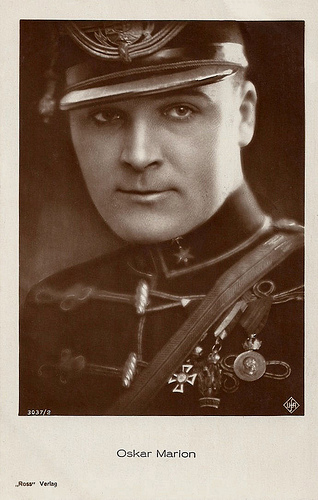
German postcard by Ross Verlag, no. 3037/2, 1928-1929. Photo: Ufa.
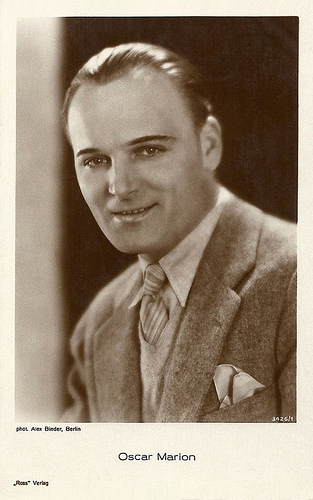
German postcard by Ross Verlag, no. 3426/1, 1928-1929. Photo: Alex Binder, Berlin.
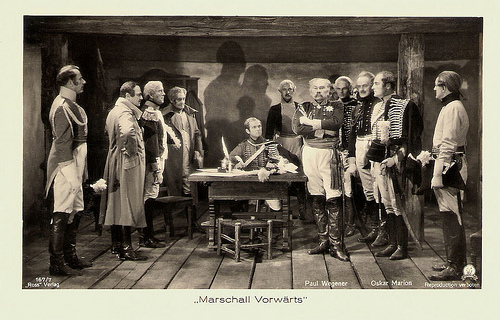
German postcard by Ross Verlag, no. 167/7. Photo: Biograph-Film. Publicity still for Marschall Vorwärts/Marshall Forward (Heinz Paul, 1932) with Paul Wegener .
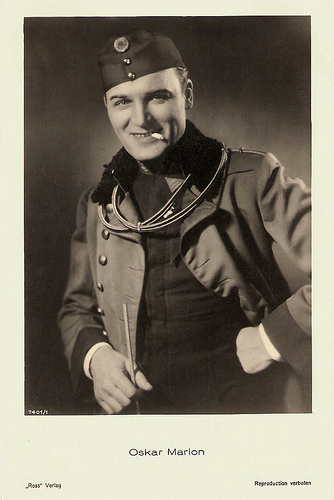
German postcard by Ross Verlag, no. 7401/1, 1932-1933.
Sources: Thomas Staedeli (Cyranos), Filmportal.de, Wikipedia (German), and .

Austrian postcard by Iris Verlag, no. 758. Photo: Verleih Engel & Walter.

German postcard by Ross Verlag, no. 1726/2, 1927-1928. Photo: Ufa.

Austrian postcard by Iris Verlag, no. 5663. Photo: E. Weill & Co. Verleih.
Elegant Lover
Oscar Marion (aka Oskar Marion) was born as Oskar Lepka in Brünn in the Austrian-Hungarian Empire (now Brno, Czech Republic) in 1894.
He studied Medicine in Vienna for some semesters and afterwards served as a sanitary during the First World War. After the war he took acting lessons in Vienna and started a stage career at the Wiener Kammerspielen, later on also at the Stadttheater in Brünn and the Landestheater in Prague.
From there he went to Berlin, where he performed in various theatres. From 1919 he was active as actor in the German cinema, often playing the elegant lover and gentleman. In the first half of the 1920s Marion played in countless films, with a record of 18 films in 1920.
Memorable titles are Die Schmugglerin/The smuggler (Eugen Burg, 1920) with Wanda Treumann , Die Glücksfalle/The lucky chance (Arthur Wellin, 1920) with Lotte Neumann , the three-part serial Fortunato (Karl Halden, 1921) with Marion as the impostor Fortunato, Strandgut der Leidenschaft/Flotsam of passion (Jaap Speyer, 1921), and Die rote Nacht/The Red Night (Jaap Speyer, 1921).
In 1922 he appeared in a.o. Die Männer der Frau Clarissa/The Men of Mrs. Clarissa (Fred Sauer, 1922), Die Frau mit den 10 Masken/The Woman with the Ten Masks (Siegfried Dessauer, 1922), Alexandra (Theo Frenkel, 1922) with Margit Barnay, Monna Vanna (Richard Eichberg, 1922) with Lee Parry , and Quarantäne/Quarantine (Max Mack, 1922) with Helena Makowska.
The next years followed such titles as Schande/Shame (Theo Frenkel, 1923) again with Makowska, Die Frau aus dem Orient/The Woman from the Orient (Wolfgang Neff, 1923) with Marion in the lead and Hedda Vernon co-starring, Taras Bulba (Vladimir Strizevskij, 1924) one of Taras Bulba’s sons with again Helena Makowska , Kampf um die Scholle/Struggle for the Soil (Erich Waschneck, 1925), and the part documentary part science fiction film Wunder der Schöpfung/Wonders of Creation (Hans Walter Kornblum, Rudolf Biebrach, Johannes Meyer, 1925).

German postcard by Ross Verlag, no. 989/3, 1925-1926. Photo: Ufa. Publicity still for Kampf um die Scholle/Struggle for the Soil (Erich Waschneck, 1925).

German postcard by Ross Verlag, no. 1726/1, 1927-1928. Photo: Ufa.

German postcard by Ross Verlag, no. 1642/1, 1927-1928. Photo: Ufa.

German postcard by Ross Verlag, no. 3426/2, 1928-1929. Photo: Alex Binder, Berlin.
Super production
From the mid-1920s on, the number of films in which Oscar Marion yearly acted became less, but not his reputation. He played in Fedora (Jean Manoussi, 1926) with Lee Parry , Mein Freund, der Chauffeur/My Friend, the driver (Erich Waschneck, 1925), and Die kleine Inge und ihre drei Väter/Little Inge and her three fathers (Franz Osten, 1926).
In 1927, Marion played Prince Edwin in love with czardas dancer Sylva Varescu ( Liane Haid ) in Die Czardasfürstin/The Csardas Queen (Hanns Schwarz, 1927), while he acted again for Dutch director Jaap Speyer as the male lead in Valencia, Du schönste aller Rosen/Valencia, you the most beautiful of all roses (Jaap Speyer, 1927) about a German in love with a Spanish flower seller (Maria Dalbaicin).
Next came films like Sturmflut/Storm tide (Willy Reiber, 1927), Hast du geliebt am schönen Rhein/If you have loved on the beautiful Rhine (James Bauer, 1927), Die Lindenwirtin am Rhein/The lime landlady on the Rhine (Rolf Randolf, 1927) with Maly Delschaft , while Marion had a minor part in the super production Waterloo (Karl Grune, 1928) and a larger part in Andreas Hofer (Hanns Prechtl, 1929), starring Fritz Greiner and again Mady Delschaft .
When sound film came along, Marion worked in both the Czech cinema and the German cinema. In Czechoslovakia he acted for instance in Dobry vojak Svejk/The Good Sioldier Schwejk (1931) - the first sound film version of the adventures of Schwejk. In the sound era Marion also played in films such as Nie wieder Liebe/Never Love Again (Anatole Litvak, 1931) with Lilian Harvey , Henker, Frauen und Soldaten/Executioner, Women and Soldiers (Johannes Meyer, 1935) with Hans Albers , and Fridericus (Johannes Meyer, 1936) with Otto Gebühr .
Marion’s parts had become much smaller during the 1930's, though. From 1936 to 1937, he worked as an assistant director, alongside his acting. In 1940 he quited acting altogether and became production manager and producer at Bavaria Film.
After the war Marion worked as a production manager for various Munich based film companies, such as Eva-Film for which he produced the successful films Rosen-Resli (Harald Reinl, 1954), which turned Christine Kaufmann into a new child star, and Der schweigende Engel/The silent angel (Harald Reinl, 1954), again with Kaufmann in the lead.
A few years later, Marion stopped his film career. His last productions were Solange du lebst/As long as you live (Harald Reinl, 1955) with Marianne Koch, and Ein Sommer, den man nie vergißt/A Summer You Will Never Forget (Werner Jacobs, 1959).
Oscar Marion died in Munich in 1986, at the high age of almost 90 years.

German postcard by Ross Verlag, no. 3037/2, 1928-1929. Photo: Ufa.

German postcard by Ross Verlag, no. 3426/1, 1928-1929. Photo: Alex Binder, Berlin.

German postcard by Ross Verlag, no. 167/7. Photo: Biograph-Film. Publicity still for Marschall Vorwärts/Marshall Forward (Heinz Paul, 1932) with Paul Wegener .

German postcard by Ross Verlag, no. 7401/1, 1932-1933.
Sources: Thomas Staedeli (Cyranos), Filmportal.de, Wikipedia (German), and .
Published on February 26, 2018 22:00
February 25, 2018
Sabine Bethmann
German film actress Sabine Bethmann (1931) is best known for Fritz Langs’s Der Tiger von Eschnapur (1959) and the sequel Das Indische Grabmal (1959), together known as 'Fritz Lang's Indian Epic'.
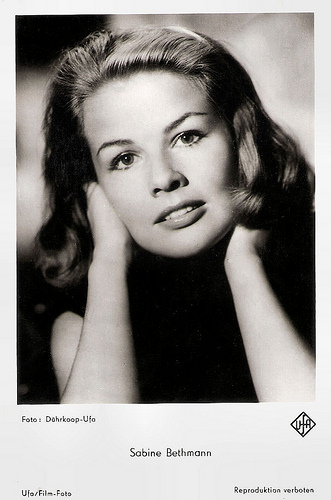
German postcard by Ufa, Berlin-Tempelhof, no. FK 4230. Photo: Dührkoop / Ufa.
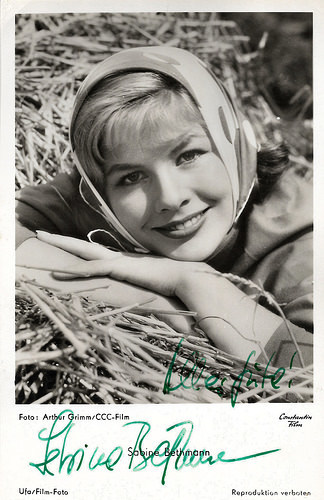
German postcard by Ufa, Berlin-Tempelhof, no. FK 4235. Photo: Arthur Grimm / CCC-Film / Constantin Film.
Spartacus
Sabine Bethmann was born in Tilsit, East Prussia (now Sovetsk, Russia), in 1931.
She studied to become a physiotherapist, but started her career as a model. At 24, she was discovered for the cinema. She made her film debut in Waldwinter/Winter in the Woods (Wolfgang Liebeneiner, 1956) starring Claus Holm .
A year later she played the girlfriend of Hansjörg Felmy in the anti-war film Haie und kleine Fische/Sharks and Small Fish (Frank Wisbar, 1957). By showing war in all its horror, as a shark devouring everyone and everything in its path, director Frank Wisbar made a powerful anti-war statement.
Bethmann then appeared in the adventure films Der Tiger von Eschnapur/The Tiger of Eschnapur (Fritz Lang, 1959) and Das Indische Grabmal/The Indian Tomb (Fritz Lang, 1959).
Fritz Lang returned to Germany to direct these films, which together tell the story of a German architect ( Paul Hubschmid ), the Indian maharajah ( Walter Reyer ) for whom he is supposed to build schools and hospitals, and the Eurasian temple dancer (Debra Paget) who comes between them. Bethmann played the sister of the architect.
She was then cast in the role of Varinia in Spartacus (1960), and began filming with Anthony Mann as director. But, when Mann was fired and Stanley Kubrick took over the direction, she was replaced with Jean Simmons.
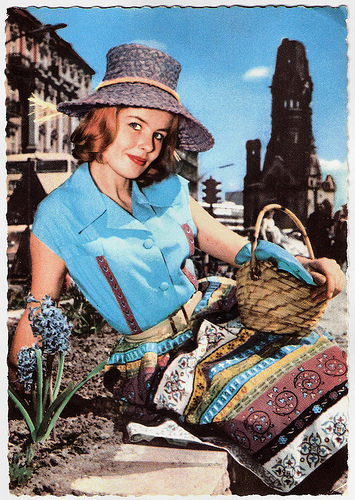
German postcard by Ufa, Berlin-Tempelhof, no. CK 193. Photo: Klaus Collignon / Ufa.
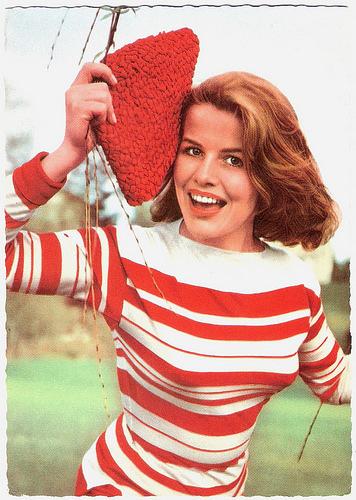
German postcard by Ufa, Berlin-Templehof, no. CK-263. Photo: Klaus Collignon.
Dr. Mabuse
Sabine Bethmann starred in the Argentine, Spanish, West-German international co-production Juanito/Viva Juanito! (Fernando Palacio, 1960), set during the Mexican Revolution and featuring Pablito Calvo .
She also played the female lead in the German crime film Scotland Yard jagt Dr. Mabuse/Scotland Yard vs. Dr Mabuse (Paul May, 1963) starring Peter van Eyck .
During the 1960s, she also appeared in the Spaghetti Western Il ranch degli spietati/Oklahoma John (Jaime Jesús Balcázar, Roberto Bianchi Montero, 1965), and the drama Mädchen hinter Gittern/Girls behind bars (Rudolf Zehetgruber, 1965) with Heidelinde Weis .
Her roles became rarer and smaller. Her last film was the German crime comedy Die Herren mit der weissen Weste/Gentlemen in White Vests (Wolfgang Staudte, 1970) with Martin Held .
Then at 40, she retired and only appeared incidentally in TV productions, such as in an episode of the Krimi series Der Alte/The Old Fox (1979). In 1990 she played one more leading role in the short children’s film Kaffeeklatsch (Sabine Eckhard, 1990).
Sabine Bethmann lives in Berlin.
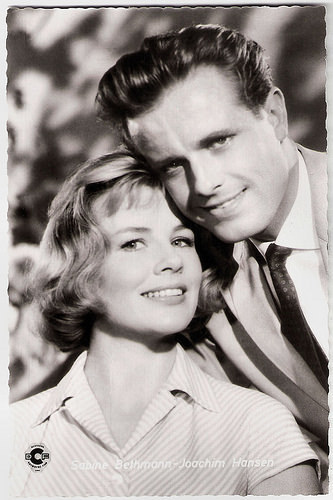
German postcard by Kolibri-Verlag GmbH, Minden/Westf., no. 895. Photo: DCF / Arthur Grimm. Publicity still for Morgen wirst du um mich weinen/Black Triangle (Alfred Braun, 1959) with Joachim Hansen .
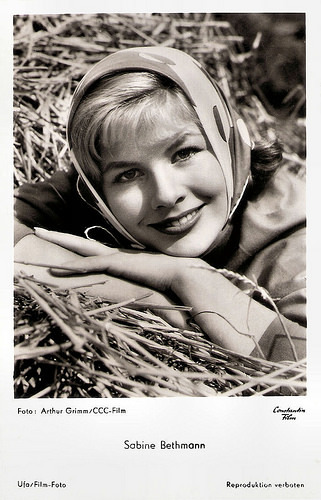
German postcard by Ufa, Berlin-Templehof, no. FK 4235. Photo: Arthur Grimm / CCC Film / Constantin Film.
Sources: Stephanie D’heil (Steffi-Line – German), AllMovie, Wikipedia (German and English), and IMDb.

German postcard by Ufa, Berlin-Tempelhof, no. FK 4230. Photo: Dührkoop / Ufa.

German postcard by Ufa, Berlin-Tempelhof, no. FK 4235. Photo: Arthur Grimm / CCC-Film / Constantin Film.
Spartacus
Sabine Bethmann was born in Tilsit, East Prussia (now Sovetsk, Russia), in 1931.
She studied to become a physiotherapist, but started her career as a model. At 24, she was discovered for the cinema. She made her film debut in Waldwinter/Winter in the Woods (Wolfgang Liebeneiner, 1956) starring Claus Holm .
A year later she played the girlfriend of Hansjörg Felmy in the anti-war film Haie und kleine Fische/Sharks and Small Fish (Frank Wisbar, 1957). By showing war in all its horror, as a shark devouring everyone and everything in its path, director Frank Wisbar made a powerful anti-war statement.
Bethmann then appeared in the adventure films Der Tiger von Eschnapur/The Tiger of Eschnapur (Fritz Lang, 1959) and Das Indische Grabmal/The Indian Tomb (Fritz Lang, 1959).
Fritz Lang returned to Germany to direct these films, which together tell the story of a German architect ( Paul Hubschmid ), the Indian maharajah ( Walter Reyer ) for whom he is supposed to build schools and hospitals, and the Eurasian temple dancer (Debra Paget) who comes between them. Bethmann played the sister of the architect.
She was then cast in the role of Varinia in Spartacus (1960), and began filming with Anthony Mann as director. But, when Mann was fired and Stanley Kubrick took over the direction, she was replaced with Jean Simmons.

German postcard by Ufa, Berlin-Tempelhof, no. CK 193. Photo: Klaus Collignon / Ufa.

German postcard by Ufa, Berlin-Templehof, no. CK-263. Photo: Klaus Collignon.
Dr. Mabuse
Sabine Bethmann starred in the Argentine, Spanish, West-German international co-production Juanito/Viva Juanito! (Fernando Palacio, 1960), set during the Mexican Revolution and featuring Pablito Calvo .
She also played the female lead in the German crime film Scotland Yard jagt Dr. Mabuse/Scotland Yard vs. Dr Mabuse (Paul May, 1963) starring Peter van Eyck .
During the 1960s, she also appeared in the Spaghetti Western Il ranch degli spietati/Oklahoma John (Jaime Jesús Balcázar, Roberto Bianchi Montero, 1965), and the drama Mädchen hinter Gittern/Girls behind bars (Rudolf Zehetgruber, 1965) with Heidelinde Weis .
Her roles became rarer and smaller. Her last film was the German crime comedy Die Herren mit der weissen Weste/Gentlemen in White Vests (Wolfgang Staudte, 1970) with Martin Held .
Then at 40, she retired and only appeared incidentally in TV productions, such as in an episode of the Krimi series Der Alte/The Old Fox (1979). In 1990 she played one more leading role in the short children’s film Kaffeeklatsch (Sabine Eckhard, 1990).
Sabine Bethmann lives in Berlin.

German postcard by Kolibri-Verlag GmbH, Minden/Westf., no. 895. Photo: DCF / Arthur Grimm. Publicity still for Morgen wirst du um mich weinen/Black Triangle (Alfred Braun, 1959) with Joachim Hansen .

German postcard by Ufa, Berlin-Templehof, no. FK 4235. Photo: Arthur Grimm / CCC Film / Constantin Film.
Sources: Stephanie D’heil (Steffi-Line – German), AllMovie, Wikipedia (German and English), and IMDb.
Published on February 25, 2018 22:00
February 24, 2018
Rolf von Goth
Handsome German film actor Rolf von Goth (1906-1981) appeared in minor roles in several silent films such as Fritz Lang’s s epic Metropolis (1927). In the late 1920s, he emerged as a prominent actor in Aufklärungsfilme (enlightenment films). During the early 1930s, he played a mixture of leading and supporting roles in dozens of films, including Es war einmal ein Walzer (1932) and Schuß im Morgengrauen (1932) but his appearances began to decline during the Nazi era. Later he switched to become a successful director and producer of radio plays.
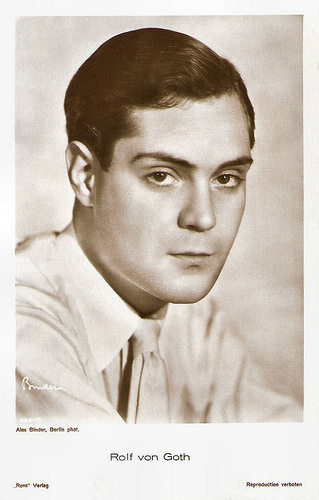
German postcard by Ross Verlag, no. 4661/1, 1929-1930. Photo: Alex Binder, Berlin.
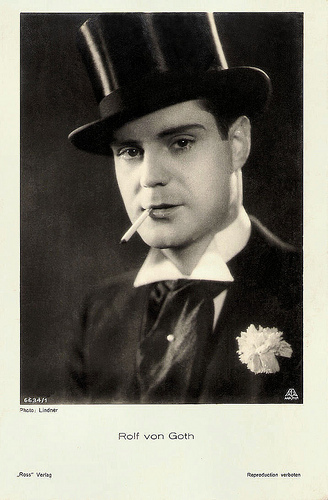
German postcard by Ross Verlag, no. 6634/1, 1931-1932. Photo: Aafa-Film / Lindner.
A son in the Eternal Gardens
Rolf von Goth was born in 1906 in Windhoek in German Southwest Africa (then a German colony, now Namibia), where his father was stationed as an officer.
First, Rolf wanted to follow in his father’s footsteps, but he decided to become an actor. The dark-haired, handsome 20-years-old moved to Germany and started a film career there.
He initially appeared in minor roles in silent films such as the classic Science-Fiction epic Metropolis (Fritz Lang, 1927) as a son in the Eternal Gardens, the comedy Don Juan in der Mädchenschule/Don Juan in a Girls' School (Reinhold Schünzel, 1928) with Adolphe Engers, and the crime film Vom Täter fehlt jede Spur/Under Suspicion (Constantin J. David, 1928) starring Hanni Weisse.
He had a bigger part in Verirrte Jugend/Misled Youth (Richard Löwenbein, 1929), starring Fritz Alberti, Erna Morena and Dolly Davis . It was one of the many Aufklärungsfilme (enlightenment films) during the Weimar Era that addressed the issue of juvenile delinquency.
Von Goth then emerged as a prominent actor with a leading role in Vater und Sohn/Father and Son (Géza von Bolváry, 1929) as the son of Harry Liedtke .
His final silent film was the Aufklärungsfilm Frühlingserwachen/Spring Awakening (Richard Oswald, 1929), with Mathilde Sussin and Toni van Eyck . It is an adaptation of the play of the same title by Frank Wedekind about the rebellion of the youth and the increasingly debated erotic exploratory experiment. Von Goth got very good reviews for his role.
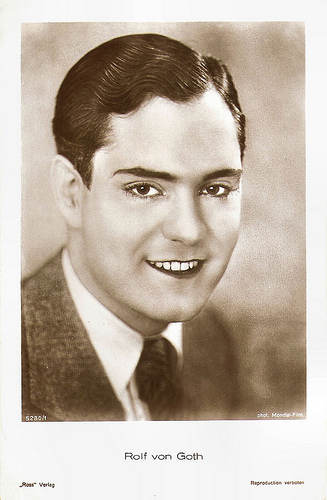
German postcard by Ross Verlag, no. 5280/1, 1930-1931. Photo: Mondial-Film.
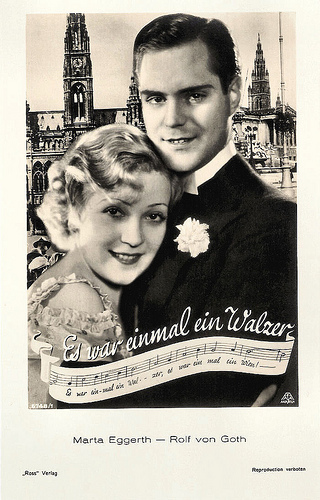
German postcard by Ross Verlag, no. 6748/1, 1931-1932. Photo: Aafa-Film. Publicity still for Es war einmal ein Walzer/Once There Was a Waltz (Victor Janson, 1932) with Márta Eggerth .
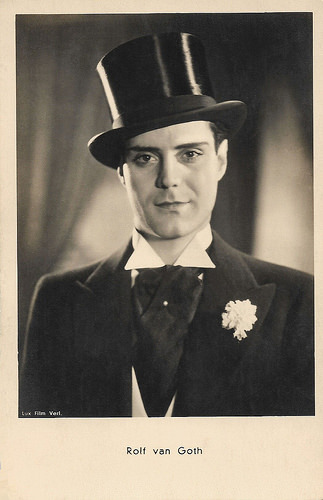
Austrian postcard by Iris Verlag, no. 6600. Photo: Lux Film Verleih.
The favourite of every mother-in-law
During the early 1930s, Rolf von Goth played a mixture of leading and supporting roles in dozens of films, of the as the son-in-law. Stefanie D’heil calls him at Steffi-Line ‘Lieblings aller Schwiegermütter’ (the favourite of every mother-in-law).
In the operetta film Es war einmal ein Walzer/Once There Was a Waltz (Victor Janson, 1932), he co-starred with Márta Eggerth and Paul Hörbiger .
He had only a minor part in the crime film Schuß im Morgengrauen/A Shot at Dawn (Alfred Zeisler, 1932), starring Ery Bos and Genia Nikolaieva . The latter was based on the play The Woman and the Emerald by Harry Jenkins and recounts a jewel theft.
Then he co-starred with Jenny Jugo in the musical comedy Fünf von der Jazzband/Five from the Jazz Band (Erich Engel, 1932), produced by the German subsidiary of Universal Pictures.
Von Goth co-starred with Karin Hardt in Die blonde Christl/The blonde Christl (Franz Seitz, 1933) and they became also a couple in real life.
His appearances began to decline during the Nazi era. One of his last major roles was in Ein Mädchen mit Prokura/A Woman With Power of Attorney (Arzén von Cserépy, 1934), featuring Gerda Maurus . In 1938, the Gestapo arrested him after being denounced. It was the abrupt end of his film career.
After the outbreak of WW II, he had to go into the army, and was later imprisoned. During the wartime he only played one more small part in the revue-film Die Frau meiner Träume/The Woman of My Dreams (Georg Jacoby, 1944), starring Marika Rökk . After that he retired from the film business.
Von Goth switched to become a director and producer of radio shows for NWDR (later the SFB) in Berlin. During the post-war years, he was extremely successful in the format and produced more than two hundred radio plays.
In 1981, Rolf von Goth passed away in West Berlin, aged 75. He was buried at the Heerstraße cemetery in Berlin. Von Goth was married to the actress Karin Hardt .
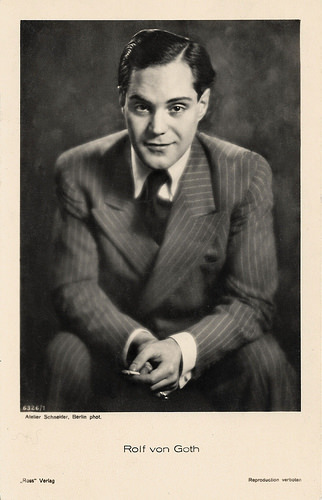
German postcard by Ross Verlag, no. 6326/1, 1931-1932. Photo: Atelier Schenker, Berlin.
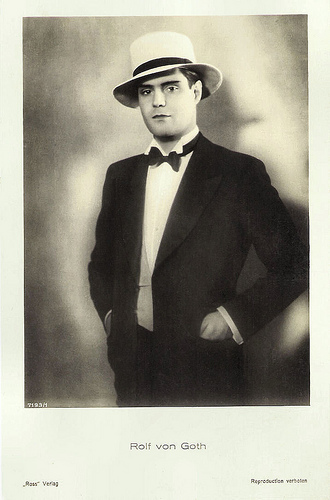
German postcard by Ross Verlag, no. 7193/1, 1932-1933.
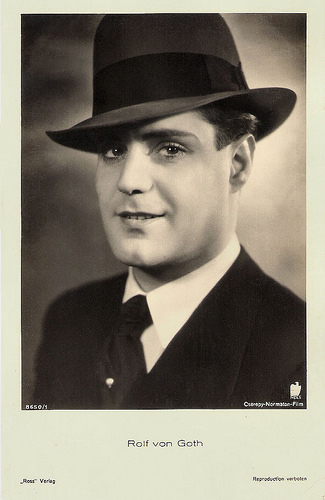
German postcard by Ross Verlag, no. 8650/1, 1933-1934. Photo: Cserepy-Normaton-Film / NDLS. Publicity still for Ein Mädchen mit Prokura/A Woman With Power of Attorney (Arzén von Cserépy, 1934).
Sources: Stephanie D’heil (Steffi-Line – German), Wikipedia (English and German), and .

German postcard by Ross Verlag, no. 4661/1, 1929-1930. Photo: Alex Binder, Berlin.

German postcard by Ross Verlag, no. 6634/1, 1931-1932. Photo: Aafa-Film / Lindner.
A son in the Eternal Gardens
Rolf von Goth was born in 1906 in Windhoek in German Southwest Africa (then a German colony, now Namibia), where his father was stationed as an officer.
First, Rolf wanted to follow in his father’s footsteps, but he decided to become an actor. The dark-haired, handsome 20-years-old moved to Germany and started a film career there.
He initially appeared in minor roles in silent films such as the classic Science-Fiction epic Metropolis (Fritz Lang, 1927) as a son in the Eternal Gardens, the comedy Don Juan in der Mädchenschule/Don Juan in a Girls' School (Reinhold Schünzel, 1928) with Adolphe Engers, and the crime film Vom Täter fehlt jede Spur/Under Suspicion (Constantin J. David, 1928) starring Hanni Weisse.
He had a bigger part in Verirrte Jugend/Misled Youth (Richard Löwenbein, 1929), starring Fritz Alberti, Erna Morena and Dolly Davis . It was one of the many Aufklärungsfilme (enlightenment films) during the Weimar Era that addressed the issue of juvenile delinquency.
Von Goth then emerged as a prominent actor with a leading role in Vater und Sohn/Father and Son (Géza von Bolváry, 1929) as the son of Harry Liedtke .
His final silent film was the Aufklärungsfilm Frühlingserwachen/Spring Awakening (Richard Oswald, 1929), with Mathilde Sussin and Toni van Eyck . It is an adaptation of the play of the same title by Frank Wedekind about the rebellion of the youth and the increasingly debated erotic exploratory experiment. Von Goth got very good reviews for his role.

German postcard by Ross Verlag, no. 5280/1, 1930-1931. Photo: Mondial-Film.

German postcard by Ross Verlag, no. 6748/1, 1931-1932. Photo: Aafa-Film. Publicity still for Es war einmal ein Walzer/Once There Was a Waltz (Victor Janson, 1932) with Márta Eggerth .

Austrian postcard by Iris Verlag, no. 6600. Photo: Lux Film Verleih.
The favourite of every mother-in-law
During the early 1930s, Rolf von Goth played a mixture of leading and supporting roles in dozens of films, of the as the son-in-law. Stefanie D’heil calls him at Steffi-Line ‘Lieblings aller Schwiegermütter’ (the favourite of every mother-in-law).
In the operetta film Es war einmal ein Walzer/Once There Was a Waltz (Victor Janson, 1932), he co-starred with Márta Eggerth and Paul Hörbiger .
He had only a minor part in the crime film Schuß im Morgengrauen/A Shot at Dawn (Alfred Zeisler, 1932), starring Ery Bos and Genia Nikolaieva . The latter was based on the play The Woman and the Emerald by Harry Jenkins and recounts a jewel theft.
Then he co-starred with Jenny Jugo in the musical comedy Fünf von der Jazzband/Five from the Jazz Band (Erich Engel, 1932), produced by the German subsidiary of Universal Pictures.
Von Goth co-starred with Karin Hardt in Die blonde Christl/The blonde Christl (Franz Seitz, 1933) and they became also a couple in real life.
His appearances began to decline during the Nazi era. One of his last major roles was in Ein Mädchen mit Prokura/A Woman With Power of Attorney (Arzén von Cserépy, 1934), featuring Gerda Maurus . In 1938, the Gestapo arrested him after being denounced. It was the abrupt end of his film career.
After the outbreak of WW II, he had to go into the army, and was later imprisoned. During the wartime he only played one more small part in the revue-film Die Frau meiner Träume/The Woman of My Dreams (Georg Jacoby, 1944), starring Marika Rökk . After that he retired from the film business.
Von Goth switched to become a director and producer of radio shows for NWDR (later the SFB) in Berlin. During the post-war years, he was extremely successful in the format and produced more than two hundred radio plays.
In 1981, Rolf von Goth passed away in West Berlin, aged 75. He was buried at the Heerstraße cemetery in Berlin. Von Goth was married to the actress Karin Hardt .

German postcard by Ross Verlag, no. 6326/1, 1931-1932. Photo: Atelier Schenker, Berlin.

German postcard by Ross Verlag, no. 7193/1, 1932-1933.

German postcard by Ross Verlag, no. 8650/1, 1933-1934. Photo: Cserepy-Normaton-Film / NDLS. Publicity still for Ein Mädchen mit Prokura/A Woman With Power of Attorney (Arzén von Cserépy, 1934).
Sources: Stephanie D’heil (Steffi-Line – German), Wikipedia (English and German), and .
Published on February 24, 2018 22:00
February 23, 2018
Pauline Brunius
In the first decades of the 20th century, Pauline Brunius (1881-1954) was the Queen of the Swedish stage. For a number of years, she also focused on film acting and directing. Later she became the first female managing director of Dramaten, the Royal Dramatic Theatre in Stockholm.
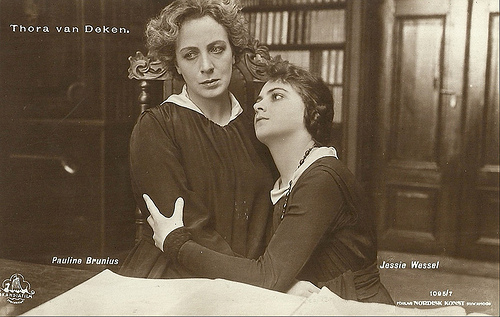
Swedish postcard by Verlag Nordisk Konst, Stockholm, no. 1095/7. Photo: Skandia Film. Pauline Brunius and Jessie Wessel in Thora van Deken (John W. Brunius, 1920).
Extremely successful in queen roles
Pauline Brunius was born Emma Maria Pauline Lindstedt in 1881 in Stockholm, the capital of Sweden. She started as a ballet girl at the Opera in 1891 where she spent ten years. From 1899 till 1902, she had private acting lessons by actress Lotten Dorsch. In 1902, she made her debut as an actress at the Olympiateatern.
During the early 20th century, Pauline Brunius acted in Stockholm's major theatres, the Svenska teatern, Vasateatern and Dramaten. She was considered 'The Queen of Swedish Theatre'. At Svensk filmdatabas , Mikaela Lindblom described her in 2012 as "a classically-educated actress with a magnificent posture, had a melodic voice and was extremely successful in queen roles."
From 1926 till 1932, she was the managing director of the Oscarsteatern together with her husband, actor and film director John W. Brunius and with star actor Gösta Ekman . They changed the operetta theatre into a respected and innovative scene for stage plays.
Pauline Brunius acted in only 13 film roles. Her cinema career started with Thora van Deken/A Mother's Fight (John W. Brunius, 1920), also with Gösta Ekman . The film was based on a short story by Henrik Pontoppidan about a divorced wife of a wealthy landowner who lies in court that her deceased ex-husband had destroyed his will to secure her daughter's inheritance. In 1914, Brunius had already performed this role on stage and the film focuses on her standout performance.
Brunius would be paired again with Gösta Ekman in Gyurkovicsarna/Lieutenant Tophat (1920) - also with Nils Asther , Kärlekens ögon/A Scarlet Angel (1922), Karl XII/Charles XII (1925), and Gustaf Wasa del I/Gustaf Wasa, Part One (1928), always directed by her husband, John W. Brunius.
The silent historical film Karl XII/Charles XII (John W. Brunius, 1925) was released in two separate parts because of its long running time of nearly six hours. The film depicts the life of Charles XII of Sweden (1682-1718) who oversaw the expansion of the Swedish Empire until its defeat at the Battle of Poltava. It was the most expensive production in Swedish history when it was made, and inspired a string of large-budget Swedish historical films.
Pauline Brunius also acted opposite Renée Björling in En vildfågel/Give Me My Son (John W. Brunius, 1921), and opposite Einar Hanson in Gunnar Hedes saga/Snowbound (Mauritz Stiller, 1923).
In 1930, she appeared in the sound film Charlotte Löwensköld (Gustaf Molander, 1930) featuring Birgit Sergelius. It is an adaptation of the 1925 novel Charlotte Löwensköld by Selma Lagerlöf. The film is almost entirely silent, with only brief dialogue sequences and a few sound effects. The film was not considered a success, and no further adaptations of Lagerlöf's work were made in her lifetime.
Brunius co-starred with Victor Sjöström in his sound film Markurells i Wadköping/Father and Son (Victor Sjöström, 1931). However, Pauline Brunius is today best remembered in Sweden for her role as the high-class Mrs. Lindberg in the social comedy Karl Fredrik regerar/Karl Fredrik Reigns (Gustaf Edgren, 1934) with Sigurd Wallén.
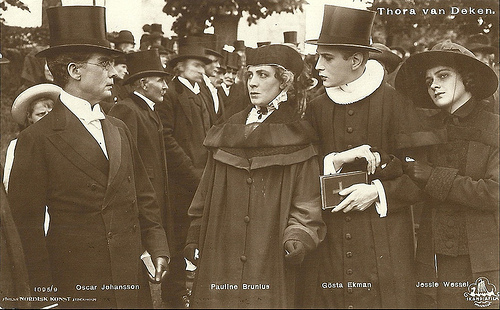
Swedish postcard by Verlag Nordisk Konst, Stockholm, no. 1095/9. Photo: Skandia Film. Pauline Brunius, Gösta Ekman , Jessie Wessel and Oscar Johansson in Thora van Deken (John W. Brunius, 1920).
Ten stormy years of stage direction
In the 1920s, Pauline Brunius made a series of short comedies based on her own scripts about the charming Stockholm family Vinner. The series started with Trollsländan/The dragonfly (Pauline Brunius, 1920). The parents were played by the true couple Frida and Olof Winnerstrand and the son Putte by Brunius' son Palle.
Six episodes were made that were shown as short films at the cinema and remind of our current situation and action comedies. Fragments are preserved from De läckra skaldjuren/The Delicious Shellfish (Pauline Brunius, 1920) and Herr Vinners stenåldersdröm/Mr. Winner's Stone Age Dream (Pauline Brunius, 1924), plus a complete version of Lev livet leende/Laugh Live Smile (Pauline Brunius, 1921).
In co-operation with her husband, Pauline Brunius directed her only feature, Falska Greta/The False Greta (John W. Brunius, Pauline Brunius, 1934). The film was inspired by the obsession about Greta Garbo 's Swedish visit in 1928. The script is kept at the Swedish Film Institute's library. Svenska Film's production manager Vilhelm Bryde approved of making the film with the addition of "an entertaining summer anniversary".
In the end the script was filmed without Svenska's participation in Finland as a Swedish-Finnish co-production. The film, with Karin Albihn playing the title role, is today considered lost. Brunius henceforth dedicated herself exclusively to theatre.
In 1938, Pauline Brunius was the first woman, who was appointed managing director of Dramaten, the Royal Dramatic Theatre in Stockholm, since the opening in 1788. She succeeded Olof Molander, who had ruled Dramaten with iron hand.
Brunius had ten stormy years at Dramaten. Leading Sweden's national theatre through the years of the Second World War can't have been easy. She was criticised for a performance by Dramaten in Berlin in 1941. Under Brunius' leadership, Marika Stiernstedt's anti-Nazi play Attentat (The Attack) was staged by Alf Sjöberg in 1944. She was praised for her consciously strong initiative at Dramaten and for her initiative to build a second stage, the Little Stage, to increase the competitiveness and capacity of the national theatre. In 1948, she resigned due to illness.
In 1954, Pauline Brunius died in Stockholm at the age of 73. She had been married to John W. Brunius from 1909 till 1935. Their children were actress Anne-Marie Brunius and actor Palle Brunius. Director Nils Brunius is Pauline Brunius's grandson.
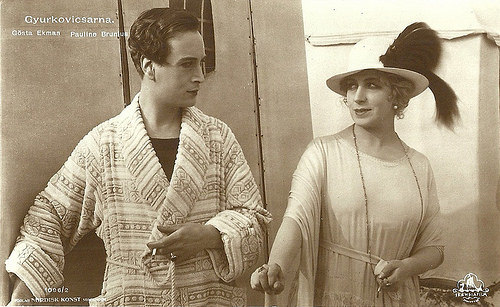
Swedish postcard by Forlag Nordisk Konst, Stockholm, no. 1096/2. Photo: Skandia Film. Gösta Ekman and Pauline Brunius in Gyurkovicsarna/Lieutenant Tophat (John W. Brunius, 1920).
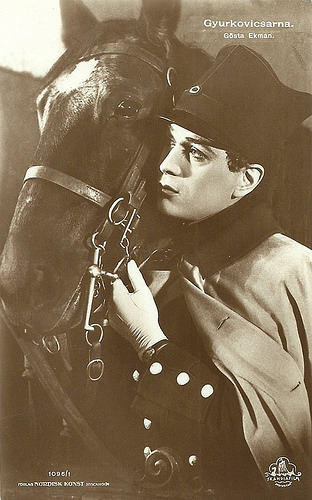
Swedish postcard by Forlag Nordisk Konst, Stockholm, no. 1096/1. Photo: Skandia Film. Gösta Ekman in Gyurkovicsarna/Lieutenant Tophat (John W. Brunius, 1920).
Source: Mikaela Kindblom (Svenska Filminstitutet/Svensk filmdatabas - Swedish), Julie Rongved Amundsen (Store norske leksikon- Norwegian), Mette Hjort and Ursula Lindqvist (A Companion to Nordic Cinema), Wikipedia (English and Swedish), and .

Swedish postcard by Verlag Nordisk Konst, Stockholm, no. 1095/7. Photo: Skandia Film. Pauline Brunius and Jessie Wessel in Thora van Deken (John W. Brunius, 1920).
Extremely successful in queen roles
Pauline Brunius was born Emma Maria Pauline Lindstedt in 1881 in Stockholm, the capital of Sweden. She started as a ballet girl at the Opera in 1891 where she spent ten years. From 1899 till 1902, she had private acting lessons by actress Lotten Dorsch. In 1902, she made her debut as an actress at the Olympiateatern.
During the early 20th century, Pauline Brunius acted in Stockholm's major theatres, the Svenska teatern, Vasateatern and Dramaten. She was considered 'The Queen of Swedish Theatre'. At Svensk filmdatabas , Mikaela Lindblom described her in 2012 as "a classically-educated actress with a magnificent posture, had a melodic voice and was extremely successful in queen roles."
From 1926 till 1932, she was the managing director of the Oscarsteatern together with her husband, actor and film director John W. Brunius and with star actor Gösta Ekman . They changed the operetta theatre into a respected and innovative scene for stage plays.
Pauline Brunius acted in only 13 film roles. Her cinema career started with Thora van Deken/A Mother's Fight (John W. Brunius, 1920), also with Gösta Ekman . The film was based on a short story by Henrik Pontoppidan about a divorced wife of a wealthy landowner who lies in court that her deceased ex-husband had destroyed his will to secure her daughter's inheritance. In 1914, Brunius had already performed this role on stage and the film focuses on her standout performance.
Brunius would be paired again with Gösta Ekman in Gyurkovicsarna/Lieutenant Tophat (1920) - also with Nils Asther , Kärlekens ögon/A Scarlet Angel (1922), Karl XII/Charles XII (1925), and Gustaf Wasa del I/Gustaf Wasa, Part One (1928), always directed by her husband, John W. Brunius.
The silent historical film Karl XII/Charles XII (John W. Brunius, 1925) was released in two separate parts because of its long running time of nearly six hours. The film depicts the life of Charles XII of Sweden (1682-1718) who oversaw the expansion of the Swedish Empire until its defeat at the Battle of Poltava. It was the most expensive production in Swedish history when it was made, and inspired a string of large-budget Swedish historical films.
Pauline Brunius also acted opposite Renée Björling in En vildfågel/Give Me My Son (John W. Brunius, 1921), and opposite Einar Hanson in Gunnar Hedes saga/Snowbound (Mauritz Stiller, 1923).
In 1930, she appeared in the sound film Charlotte Löwensköld (Gustaf Molander, 1930) featuring Birgit Sergelius. It is an adaptation of the 1925 novel Charlotte Löwensköld by Selma Lagerlöf. The film is almost entirely silent, with only brief dialogue sequences and a few sound effects. The film was not considered a success, and no further adaptations of Lagerlöf's work were made in her lifetime.
Brunius co-starred with Victor Sjöström in his sound film Markurells i Wadköping/Father and Son (Victor Sjöström, 1931). However, Pauline Brunius is today best remembered in Sweden for her role as the high-class Mrs. Lindberg in the social comedy Karl Fredrik regerar/Karl Fredrik Reigns (Gustaf Edgren, 1934) with Sigurd Wallén.

Swedish postcard by Verlag Nordisk Konst, Stockholm, no. 1095/9. Photo: Skandia Film. Pauline Brunius, Gösta Ekman , Jessie Wessel and Oscar Johansson in Thora van Deken (John W. Brunius, 1920).
Ten stormy years of stage direction
In the 1920s, Pauline Brunius made a series of short comedies based on her own scripts about the charming Stockholm family Vinner. The series started with Trollsländan/The dragonfly (Pauline Brunius, 1920). The parents were played by the true couple Frida and Olof Winnerstrand and the son Putte by Brunius' son Palle.
Six episodes were made that were shown as short films at the cinema and remind of our current situation and action comedies. Fragments are preserved from De läckra skaldjuren/The Delicious Shellfish (Pauline Brunius, 1920) and Herr Vinners stenåldersdröm/Mr. Winner's Stone Age Dream (Pauline Brunius, 1924), plus a complete version of Lev livet leende/Laugh Live Smile (Pauline Brunius, 1921).
In co-operation with her husband, Pauline Brunius directed her only feature, Falska Greta/The False Greta (John W. Brunius, Pauline Brunius, 1934). The film was inspired by the obsession about Greta Garbo 's Swedish visit in 1928. The script is kept at the Swedish Film Institute's library. Svenska Film's production manager Vilhelm Bryde approved of making the film with the addition of "an entertaining summer anniversary".
In the end the script was filmed without Svenska's participation in Finland as a Swedish-Finnish co-production. The film, with Karin Albihn playing the title role, is today considered lost. Brunius henceforth dedicated herself exclusively to theatre.
In 1938, Pauline Brunius was the first woman, who was appointed managing director of Dramaten, the Royal Dramatic Theatre in Stockholm, since the opening in 1788. She succeeded Olof Molander, who had ruled Dramaten with iron hand.
Brunius had ten stormy years at Dramaten. Leading Sweden's national theatre through the years of the Second World War can't have been easy. She was criticised for a performance by Dramaten in Berlin in 1941. Under Brunius' leadership, Marika Stiernstedt's anti-Nazi play Attentat (The Attack) was staged by Alf Sjöberg in 1944. She was praised for her consciously strong initiative at Dramaten and for her initiative to build a second stage, the Little Stage, to increase the competitiveness and capacity of the national theatre. In 1948, she resigned due to illness.
In 1954, Pauline Brunius died in Stockholm at the age of 73. She had been married to John W. Brunius from 1909 till 1935. Their children were actress Anne-Marie Brunius and actor Palle Brunius. Director Nils Brunius is Pauline Brunius's grandson.

Swedish postcard by Forlag Nordisk Konst, Stockholm, no. 1096/2. Photo: Skandia Film. Gösta Ekman and Pauline Brunius in Gyurkovicsarna/Lieutenant Tophat (John W. Brunius, 1920).

Swedish postcard by Forlag Nordisk Konst, Stockholm, no. 1096/1. Photo: Skandia Film. Gösta Ekman in Gyurkovicsarna/Lieutenant Tophat (John W. Brunius, 1920).
Source: Mikaela Kindblom (Svenska Filminstitutet/Svensk filmdatabas - Swedish), Julie Rongved Amundsen (Store norske leksikon- Norwegian), Mette Hjort and Ursula Lindqvist (A Companion to Nordic Cinema), Wikipedia (English and Swedish), and .
Published on February 23, 2018 22:00
Paul van Yperen's Blog
- Paul van Yperen's profile
- 13 followers
Paul van Yperen isn't a Goodreads Author
(yet),
but they
do have a blog,
so here are some recent posts imported from
their feed.



